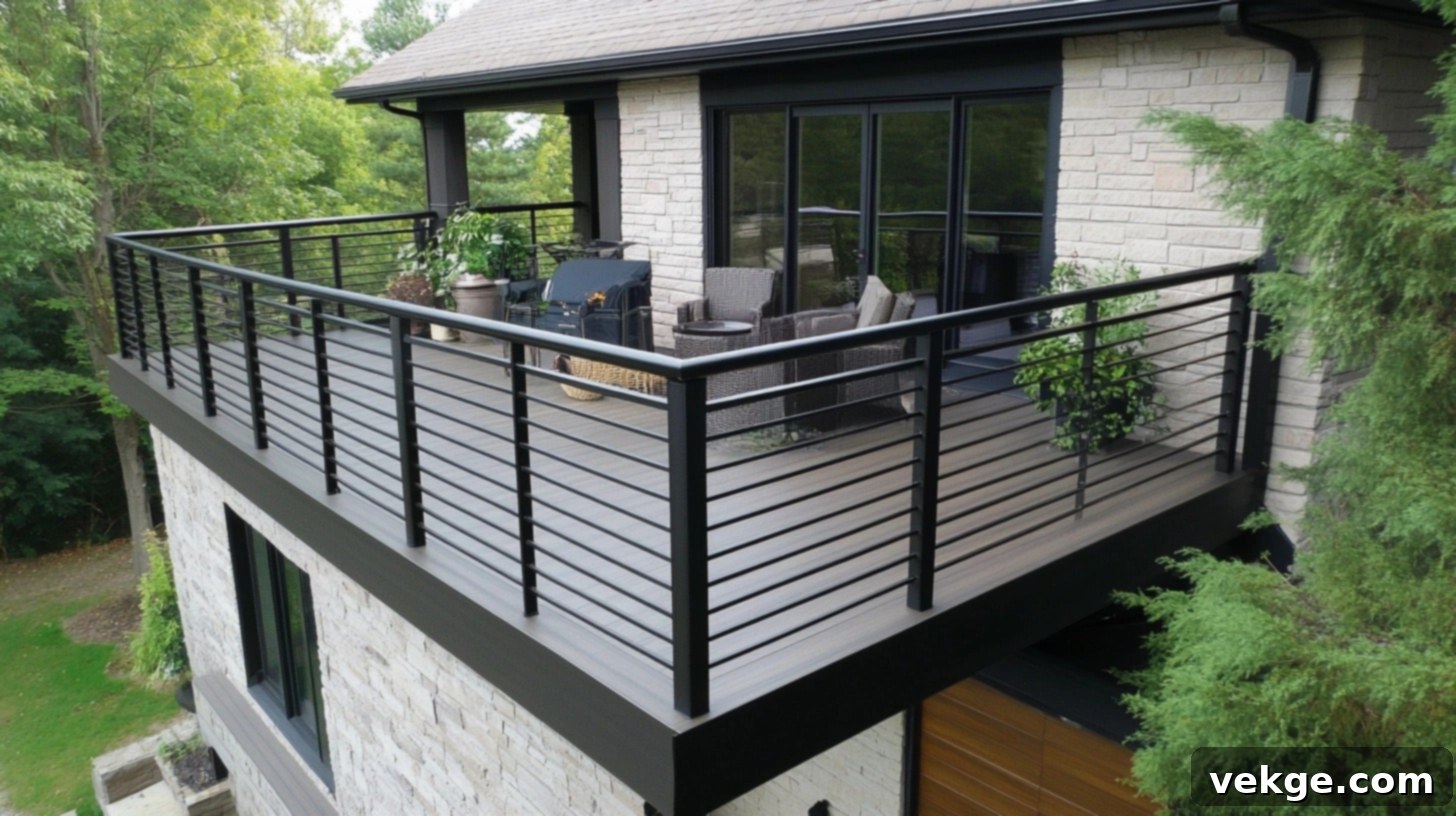25 Modern Horizontal Deck Railing Ideas: Elevate Your Outdoor Space with Style and Safety
Are you contemplating a refresh for your deck’s appearance, seeking to blend contemporary design with robust functionality? You’re in the right place!
Horizontal deck railings are experiencing a surge in popularity among homeowners who desire a sleek, modern, and uncluttered aesthetic for their outdoor living areas. Beyond their primary role in ensuring safety, these innovative designs serve as a significant visual upgrade, transforming your deck into a standout feature of your home.
While traditional vertical railings remain a common sight, horizontal options introduce a fresh, expansive style that can make your outdoor space feel considerably larger and more open. This design choice not only enhances views but also contributes to a sophisticated, contemporary ambiance.
We are thrilled to present 25 creative horizontal deck railing designs that perfectly marry style with essential safety features. Our selection covers a wide spectrum, from the minimalist elegance of sleek metal cables to the warm, inviting charm of wooden slats. Regardless of your home’s architectural style or your project budget, you’re sure to discover options that resonate with your vision.
We are confident that these diverse ideas will inspire and empower you to craft a safe, stylish, and truly inviting outdoor retreat that you and your family will cherish for years to come.
Best Horizontal Deck Railing Ideas to Try for a Modern Look
1. Cable Railings
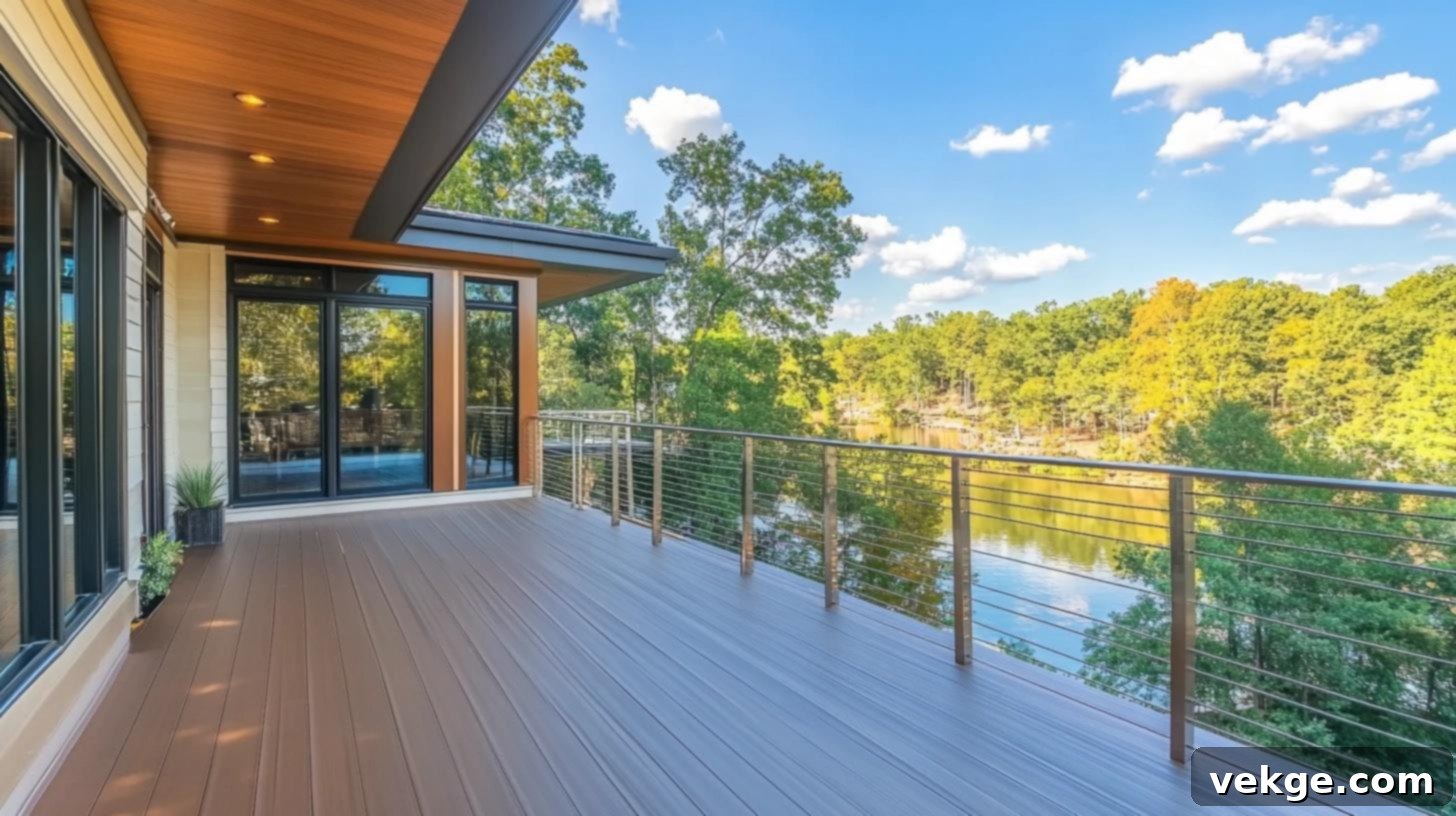
Stainless steel cables, typically 1/8 to 1/4 inch in diameter, are strung horizontally between robust metal posts, delivering a remarkably clean, minimalist aesthetic. These cables are secured with specialized end fittings and expertly tensioned to maintain perfectly straight lines, offering an almost invisible barrier that complements contemporary architecture beautifully.
Cost: Expect to pay $150-200 per linear foot. This cost can vary depending on the quality of stainless steel, the complexity of the installation, and the type of posts used (e.g., wood vs. metal).
Benefits:
- Maintains Clear Sightlines: The thin profile of the cables ensures an unobstructed view, allowing you to fully appreciate your surroundings without visual barriers.
- Requires Minimal Cleaning and Upkeep: Stainless steel is highly resistant to corrosion and dirt, demanding only occasional wiping to retain its pristine appearance.
- Strong Enough to Meet Safety Codes: Despite their slender look, properly installed cable railings are incredibly strong and fully comply with stringent safety regulations.
2. Wooden Slats
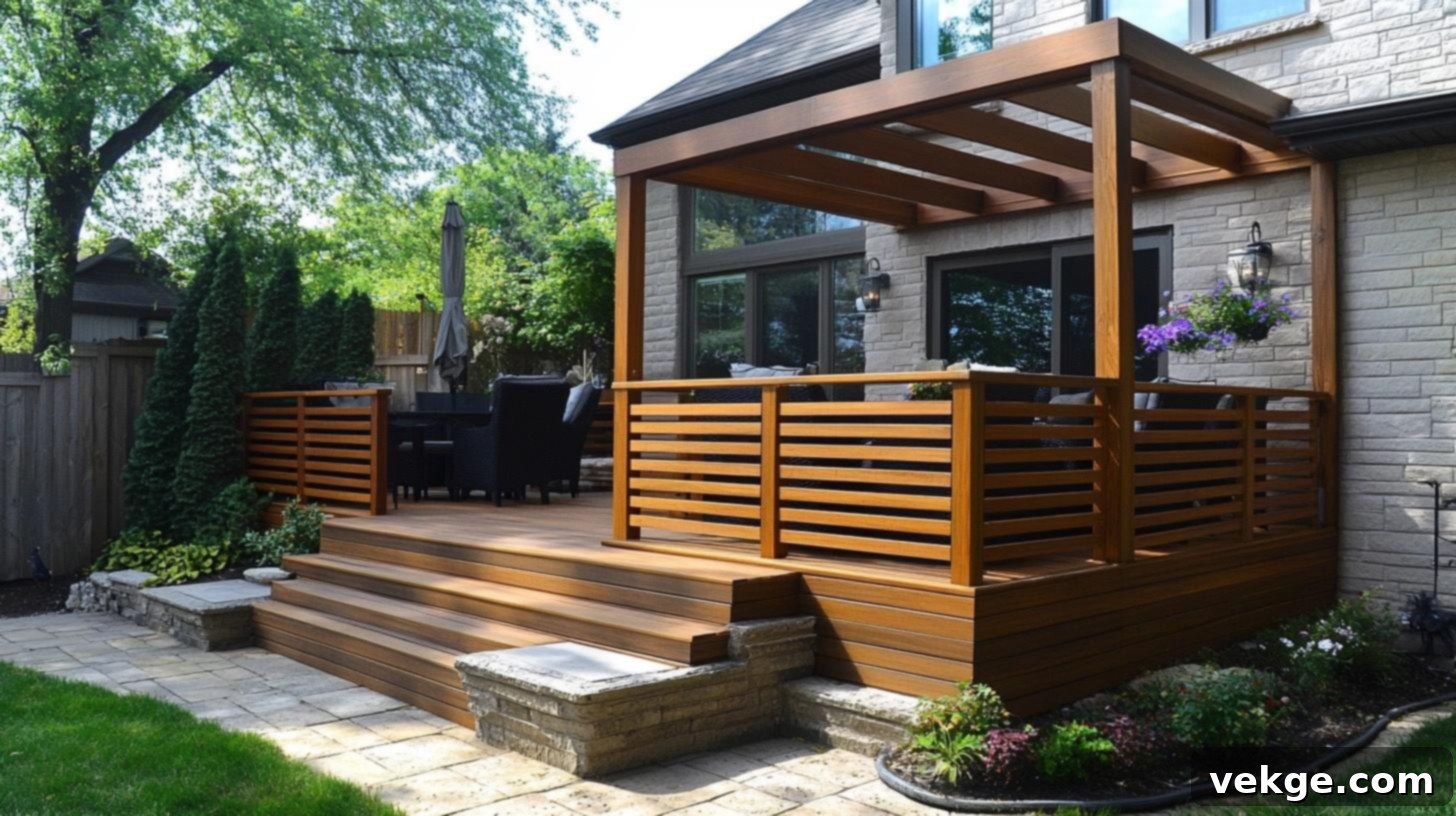
Thin wooden boards, usually 2-4 inches wide, are mounted horizontally between posts to provide a natural and inviting touch to your deck’s perimeter. The spacing between these slats can be customized to achieve your desired level of privacy or openness. This versatile style integrates seamlessly with both traditional and cutting-edge home designs, adding warmth and texture.
Cost: Priced around $50-75 per linear foot, the cost for wooden slats depends on the type of wood selected (e.g., pressure-treated pine, cedar, redwood), the finish, and installation labor.
Benefits:
- Offers Flexibility in Spacing for Desired Privacy: You can choose tighter spacing for more seclusion or wider gaps to allow greater airflow and visibility.
- Brings Natural Warmth to the Space: Wood inherently adds an organic, welcoming feel, making your deck feel more like an extension of your home.
- Can be Stained or Painted to Match Your Deck: The ability to customize the finish allows for perfect coordination with your existing deck and home exterior, enhancing curb appeal.
3. Metal Pipe Railings
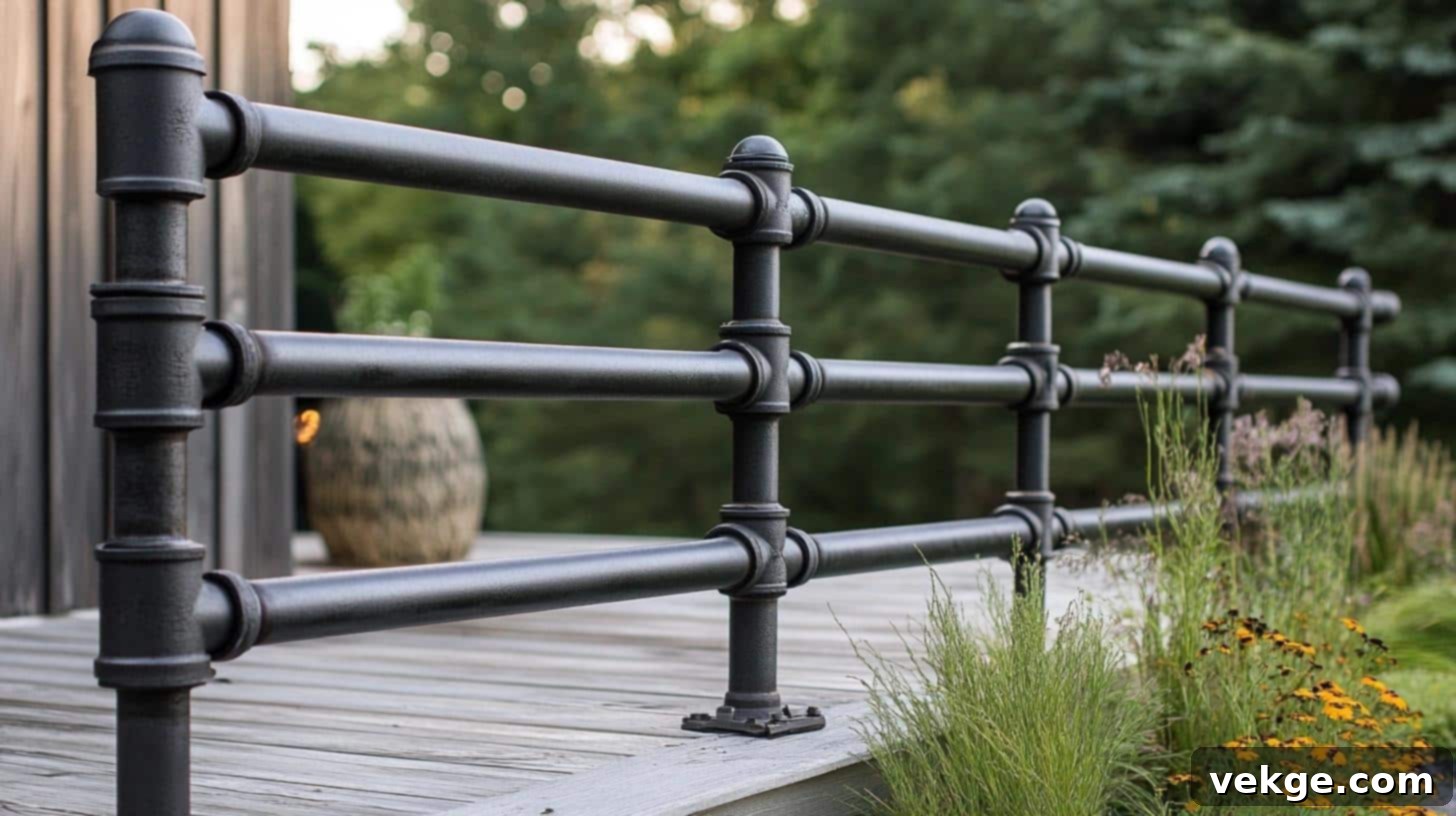
Constructed from black or galvanized steel pipes, typically 1-2 inches in diameter, these railings forge a sturdy barrier with a distinct industrial aesthetic. The pipes are securely attached to metal posts using specialized fittings, creating a robust and edgy look. This option is an excellent match for urban-style residences, loft apartments, and converted industrial spaces.
Cost: Budget approximately $90-120 per linear foot. Factors influencing this price include the grade of steel, the finish (galvanized, powder-coated), and the complexity of fittings.
Benefits:
- Withstands Heavy Use and Impact: Metal pipes are exceptionally durable, capable of enduring significant wear and tear, making them ideal for high-traffic areas.
- Needs Minimal Maintenance: Steel is inherently robust and requires little more than occasional cleaning to prevent rust or maintain its finish, offering long-lasting performance.
- Provides Solid Support for Hanging Plants or Lights: Their strength makes them perfect for decorating with string lights, small planters, or other outdoor accessories, enhancing your deck’s ambiance.
4. Glass Panels
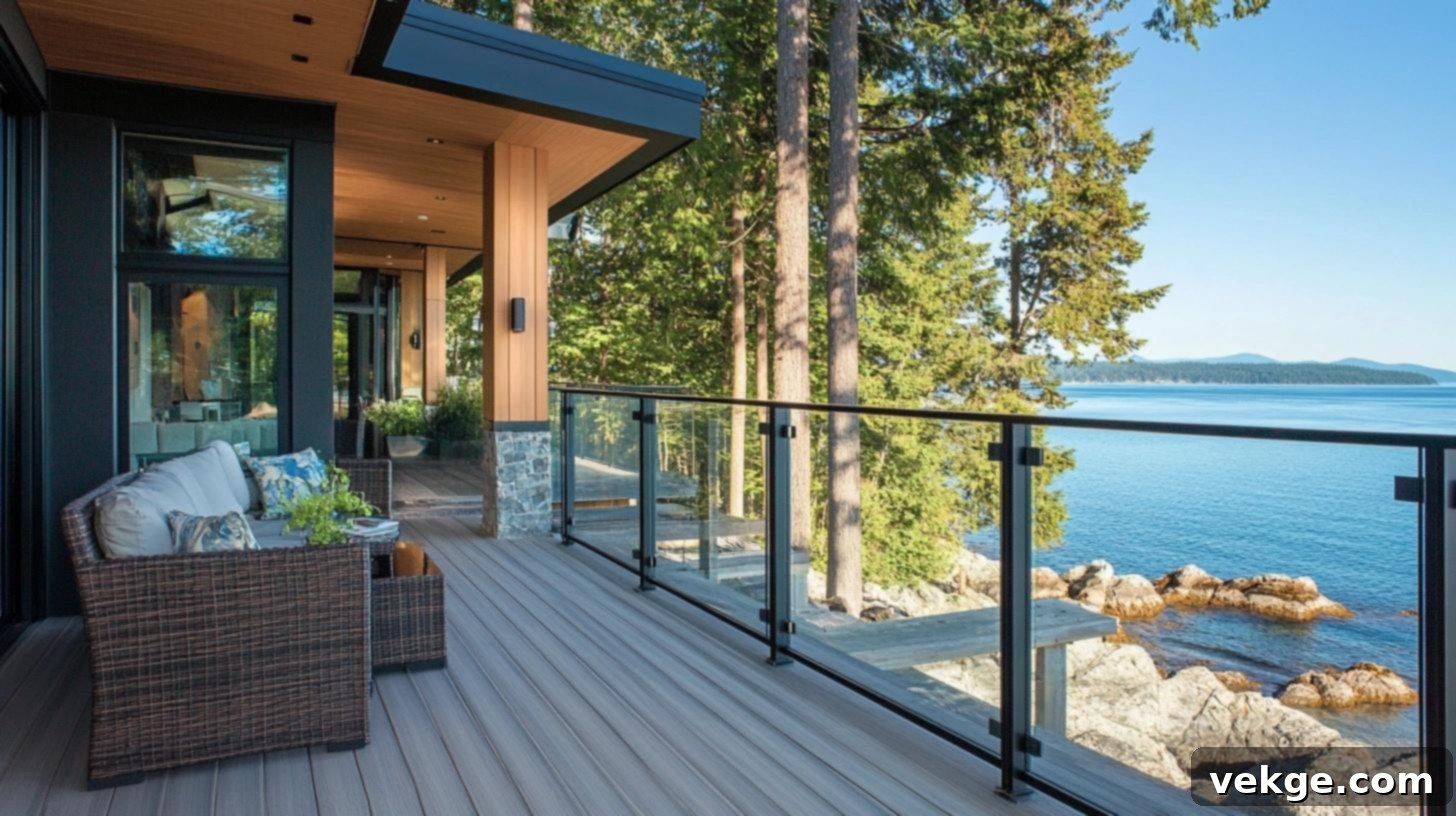
Tempered glass panels, ranging from 1/4 to 1/2 inch thick, are set within sleek aluminum or steel frames to form a transparent barrier that preserves your panoramic views. Available in clear or frosted options, these panels offer an elegant, sophisticated touch. This style is particularly stunning for seaside decks, homes with breathtaking landscapes, and modern architectural designs, providing a luxurious feel.
Cost: Expect costs ranging from $150-200 per linear foot. This pricing reflects the specialized materials, precision cutting, and professional installation required for glass railings.
Benefits:
- Blocks Wind While Keeping Views Clear: Glass acts as an effective windbreak, making your deck more comfortable, all while maintaining completely unobstructed vistas.
- Protects Small Children and Pets Safely: The solid, gap-free surface of glass panels provides a superior safety barrier, preventing pets and small children from squeezing through.
- Creates an Upscale, Polished Look: Glass railings instantly elevate the aesthetic of any deck, imbuing it with a sense of modern luxury and refined elegance.
5. Metal Bars
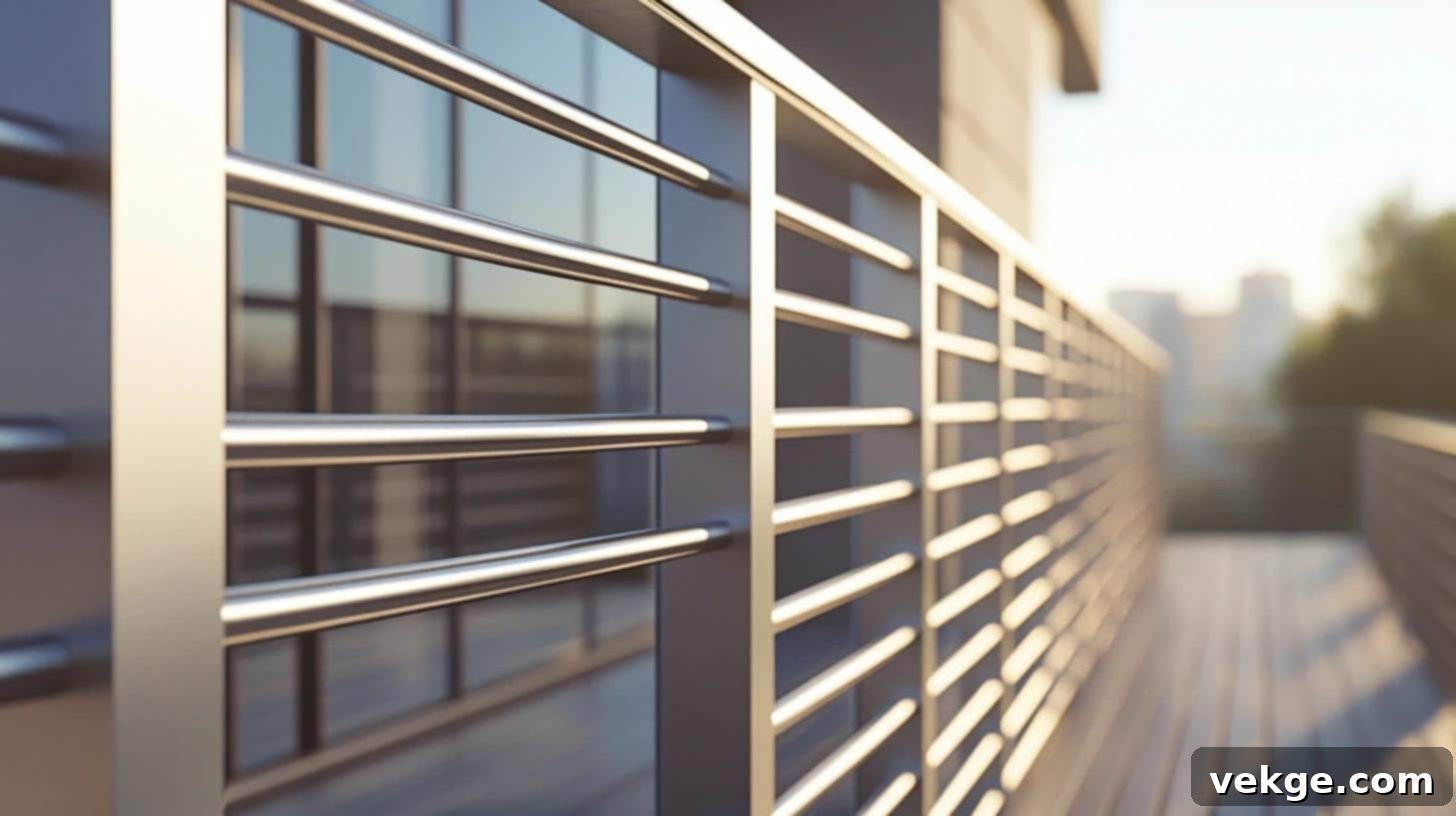
Smooth aluminum or steel bars, typically 1-1.5 inches thick, are precisely positioned horizontally to create a straightforward yet structured border. These bars are usually welded or bolted to posts for maximum stability and a seamless appearance. This minimalist design perfectly complements contemporary and minimalist home styles, offering a clean, architectural look without fuss.
Cost: These generally cost $80-120 per linear foot. The specific metal type (aluminum often being more affordable than steel), finish, and installation method will influence the final price.
Benefits:
- Stands Up to All Weather Conditions: Metal bars are incredibly durable and resistant to the elements, ensuring longevity and minimal weather-related damage.
- Requires Only Occasional Wipe-Downs: Their smooth, non-porous surface makes cleaning effortless, typically requiring just a quick wipe to remove dirt and dust.
- Allows Partial Views Through Spacing: While providing a secure barrier, the spacing between bars still allows for glimpses of the surrounding environment, balancing privacy and openness.
6. PVC Pipe Railings
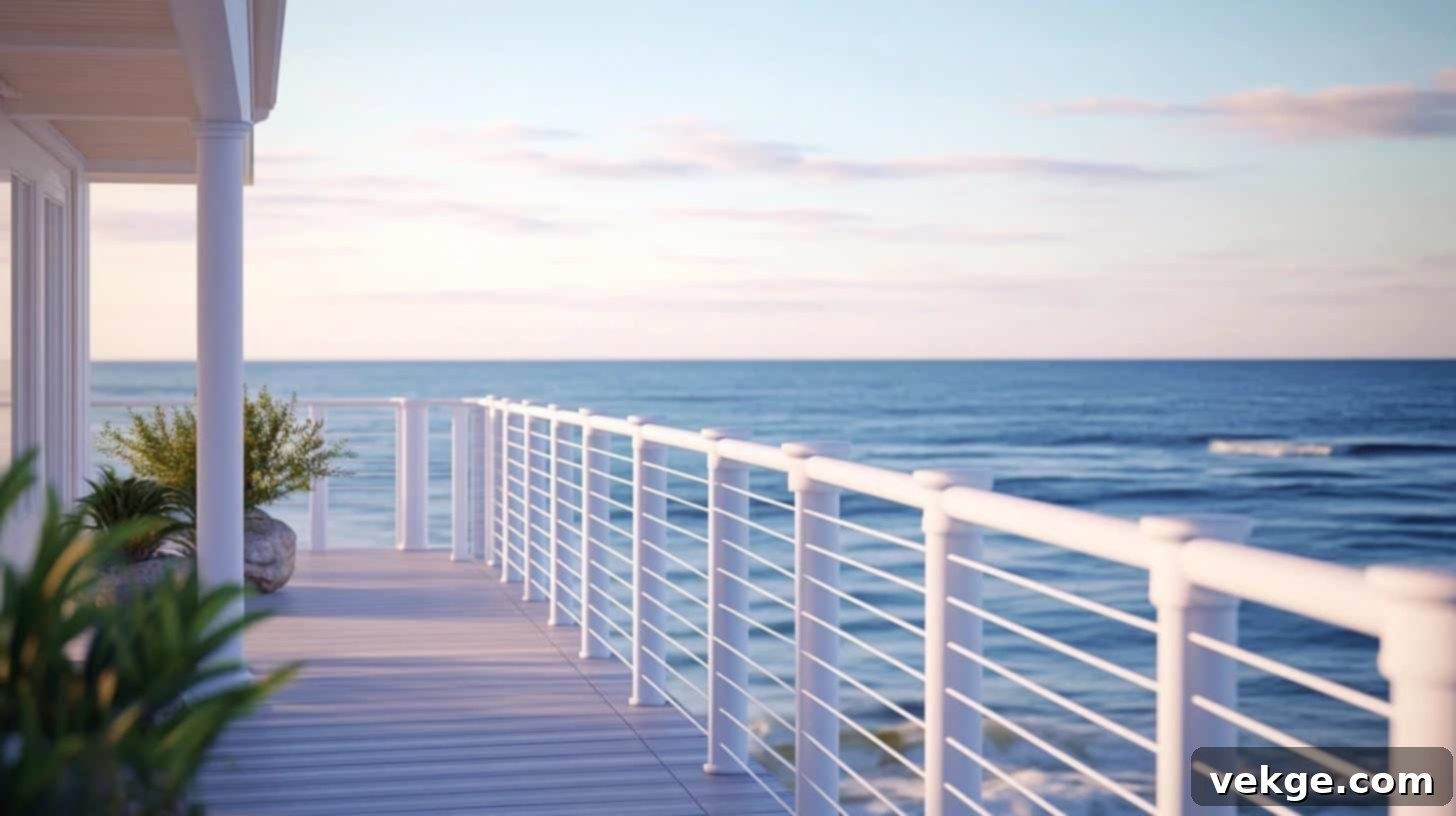
Weather-resistant PVC pipes, typically 2 inches in diameter, are arranged horizontally to form a highly budget-friendly barrier. These pipes are available in various pre-colored options or can be painted to match any desired aesthetic. This practical and durable option is particularly well-suited for pool areas, beach properties, and family-friendly decks where easy maintenance is a priority.
Cost: An attractive price point of $40-80 per linear foot, including installation, makes PVC a highly economical choice, offering great value for money.
Benefits:
- Never Needs Repainting: PVC’s inherent color means it won’t chip, peel, or fade, eliminating the need for periodic repainting and saving maintenance time.
- Resists Water Damage: Impervious to moisture, PVC railings are an excellent choice for areas exposed to water, such as poolside decks, as they won’t rot or warp.
- Stays Cool to Touch: Unlike metal, PVC pipes tend to remain cooler under direct sunlight, making them more comfortable to lean on during hot days.
7. Rope Railings
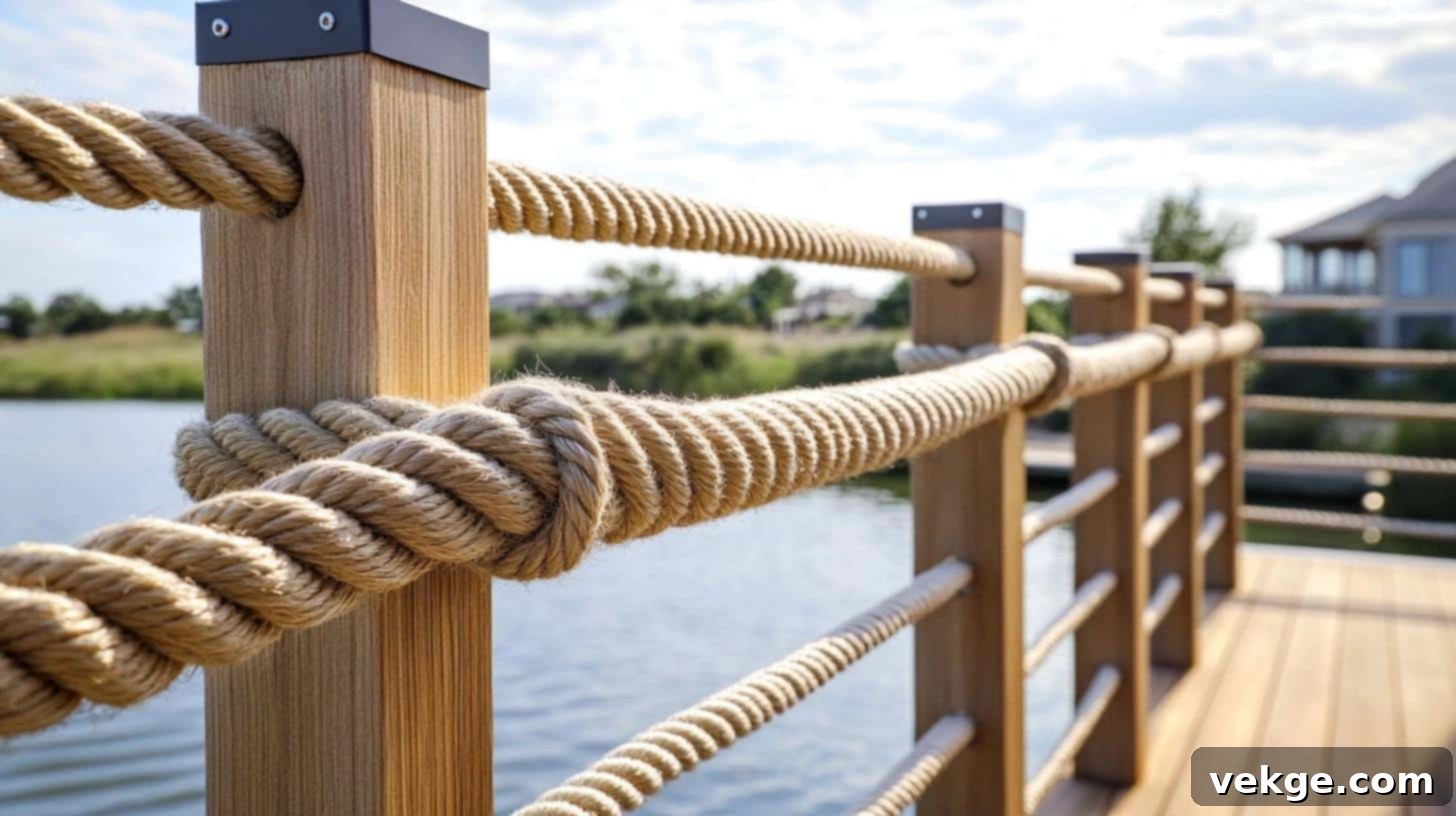
Crafted from marine-grade rope, typically 3/4 to 1 inch thick, this railing style runs horizontally through sturdy metal supports, instantly infusing your deck with a charming coastal or nautical vibe. The ropes are pulled taut and meticulously secured with marine-quality knots or durable metal clamps, creating a distinctive and relaxed aesthetic. This unique look perfectly suits beach houses, waterfront properties, and casual outdoor settings.
Cost: An affordable choice at $15-30 per linear foot. Costs depend on the type and thickness of the marine-grade rope, as well as the quality of the support hardware used.
Benefits:
- Adds a Unique Seaside Character: Rope railings are unparalleled in their ability to evoke a relaxed, beachy atmosphere, making your deck feel like a seaside escape.
- Feels Soft and Comfortable to Touch: Unlike hard metal or wood, rope offers a pleasant, tactile experience, inviting users to lean and relax comfortably against it.
- Works Well in Coastal Environments: Marine-grade rope is specifically designed to withstand harsh salty air and humid conditions, ensuring durability in coastal settings.
8. Horizontal Wire Mesh
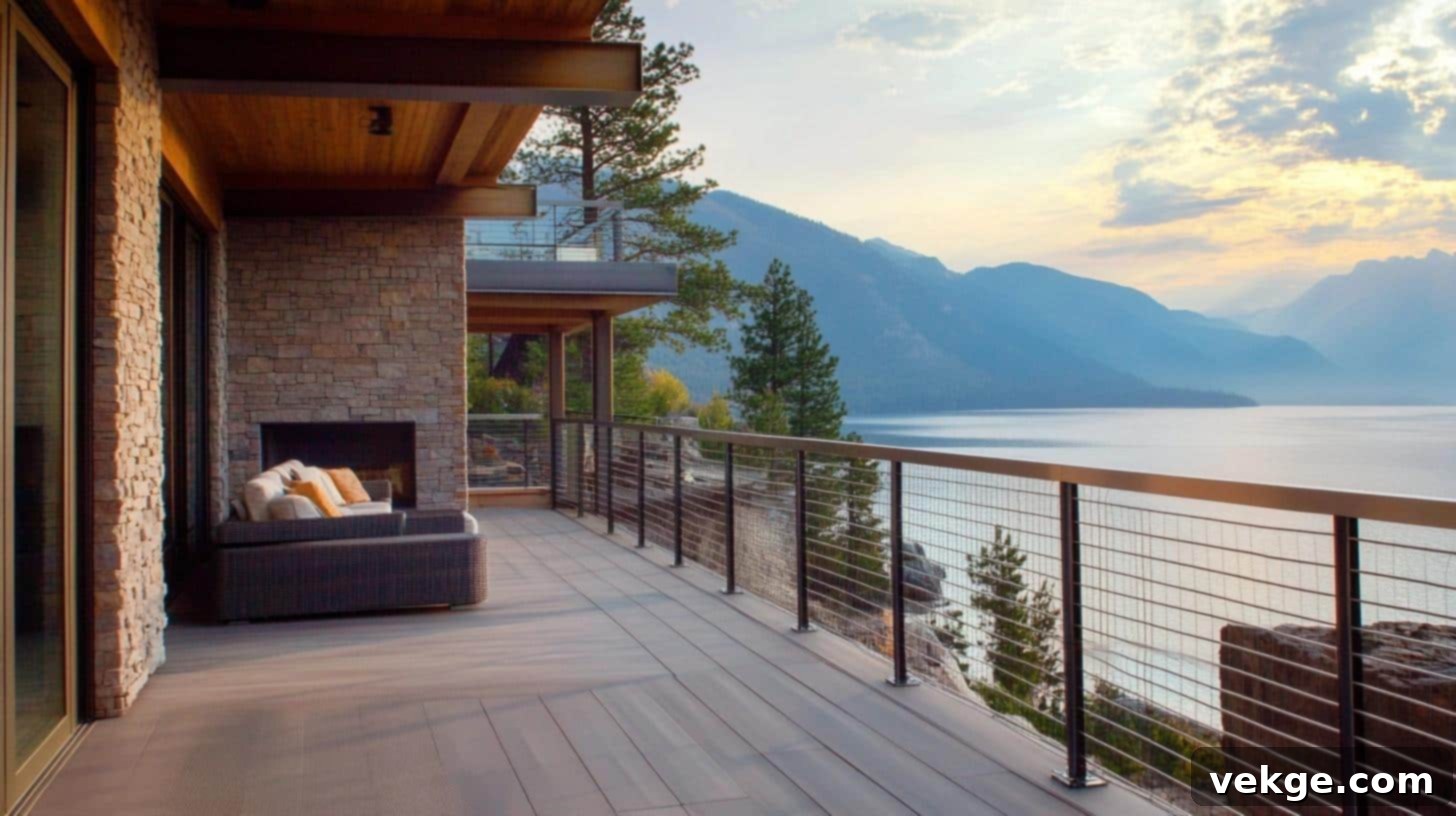
Stainless steel mesh panels, featuring 2-3 inch openings, are expertly stretched between posts to form a barrier that is both sturdy and remarkably see-through. These panels can be purchased as pre-made sections or custom-fitted to your deck’s dimensions, offering flexibility in design. This practical and stylish option is suitable for a wide range of properties, from modern city homes to serene mountain retreats, providing security without sacrificing views.
Cost: A moderate investment at $40-60 per linear foot. Pricing varies based on the gauge of the wire, the mesh pattern, and whether you opt for pre-made or custom panels.
Benefits:
- Prevents Climbing by Small Children: The tight mesh pattern effectively deters climbing, offering a safer environment for families with young children and pets.
- Allows Excellent Airflow: The open weave of the mesh ensures continuous air circulation, keeping your deck feeling fresh and comfortable, especially on warm days.
- Stops Items from Falling Through: The small openings in the mesh prevent toys, small objects, or even pets from slipping through the railing, adding an extra layer of safety.
9. Staggered Wood and Metal
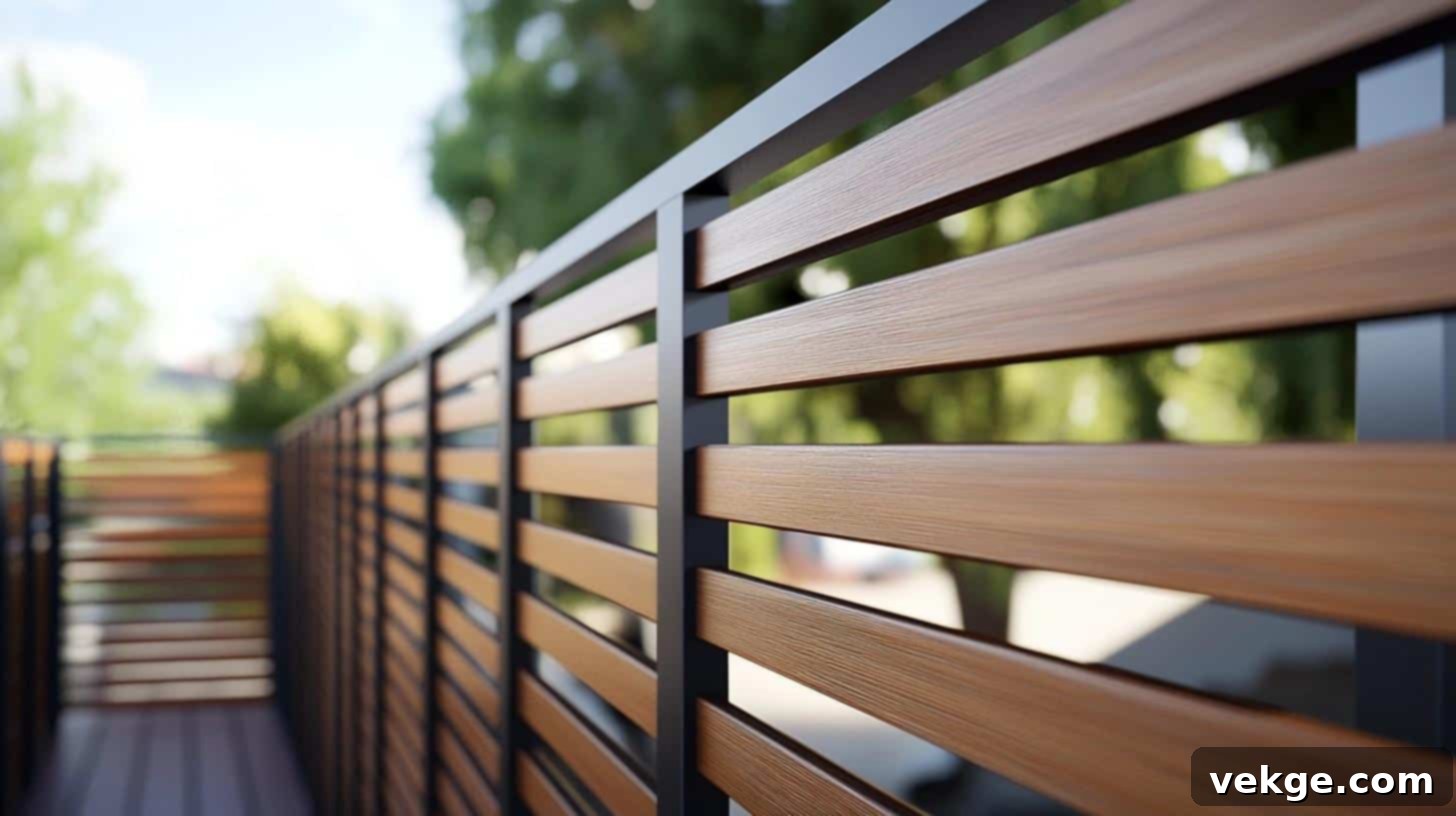
This design ingeniously combines alternating sections of wooden boards and sleek metal rails, creating a visually dynamic and eye-catching pattern. The materials are carefully spaced to balance dark metal tones with lighter wood hues, generating compelling visual interest and a sense of depth. This sophisticated design is ideal for homes that successfully blend traditional charm with modern elements, offering a unique architectural statement.
Cost: Expect costs around $45-75 per linear foot. The price will depend on the types of wood and metal chosen, the complexity of the staggered pattern, and installation.
Benefits:
- Makes a Bold Visual Statement: The contrasting materials and staggered arrangement create a distinctive, artistic look that immediately draws attention and admiration.
- Handles Weather Changes Well: The combination of durable wood (often treated or naturally resistant) and resilient metal ensures excellent performance across various weather conditions.
- Mixes Textures for Added Interest: The interplay between the smooth, cool metal and the warm, grainy wood introduces a rich textural variety that enhances the deck’s tactile and visual appeal.
10. Perforated Metal Panels
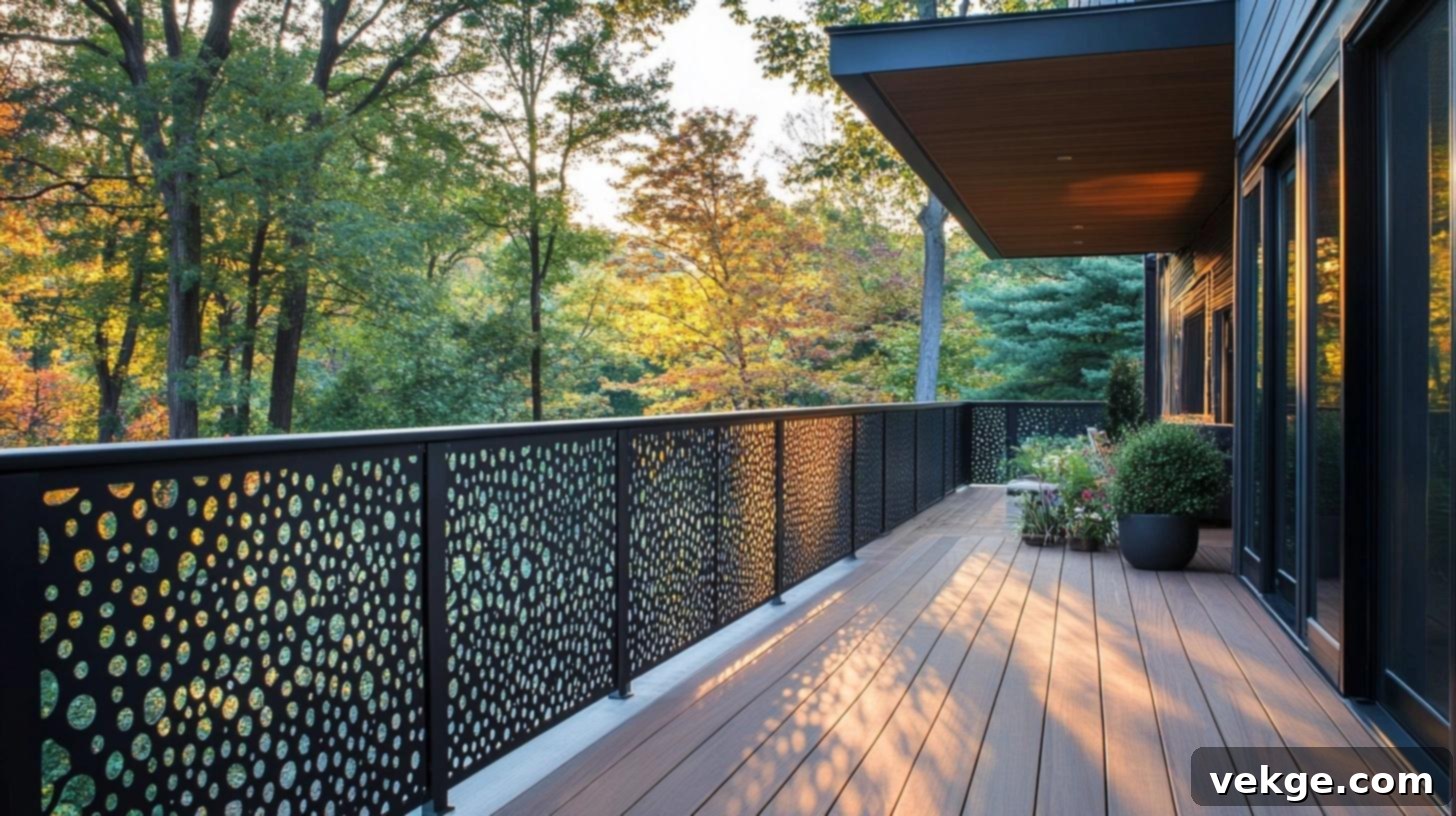
Aluminum or steel sheets, typically 1/8 inch thick, are custom-cut with various hole sizes and intricate patterns to create striking visual effects. These perforated panels not only provide a secure barrier but also artfully filter light and views, casting interesting shadows. This contemporary style integrates beautifully with both urban homes and modern suburban designs, offering a blend of privacy, light play, and artistic flair.
Cost: This premium option ranges from $150-300 per linear foot. Pricing reflects the custom design, precision cutting, material quality, and specialized installation of the panels.
Benefits:
- Allows Customized Pattern Choices: Homeowners can select from an array of patterns, or even create their own, making the railing a unique and personalized piece of art.
- Filters Sunlight into Interesting Shadows: The perforations transform direct sunlight into dynamic patterns of light and shadow on your deck, adding an enchanting dimension throughout the day.
- Combines Safety with Artistic Flair: These panels offer robust safety and security while simultaneously serving as a captivating design element, showcasing a sophisticated balance of form and function.
11. Corrugated Metal
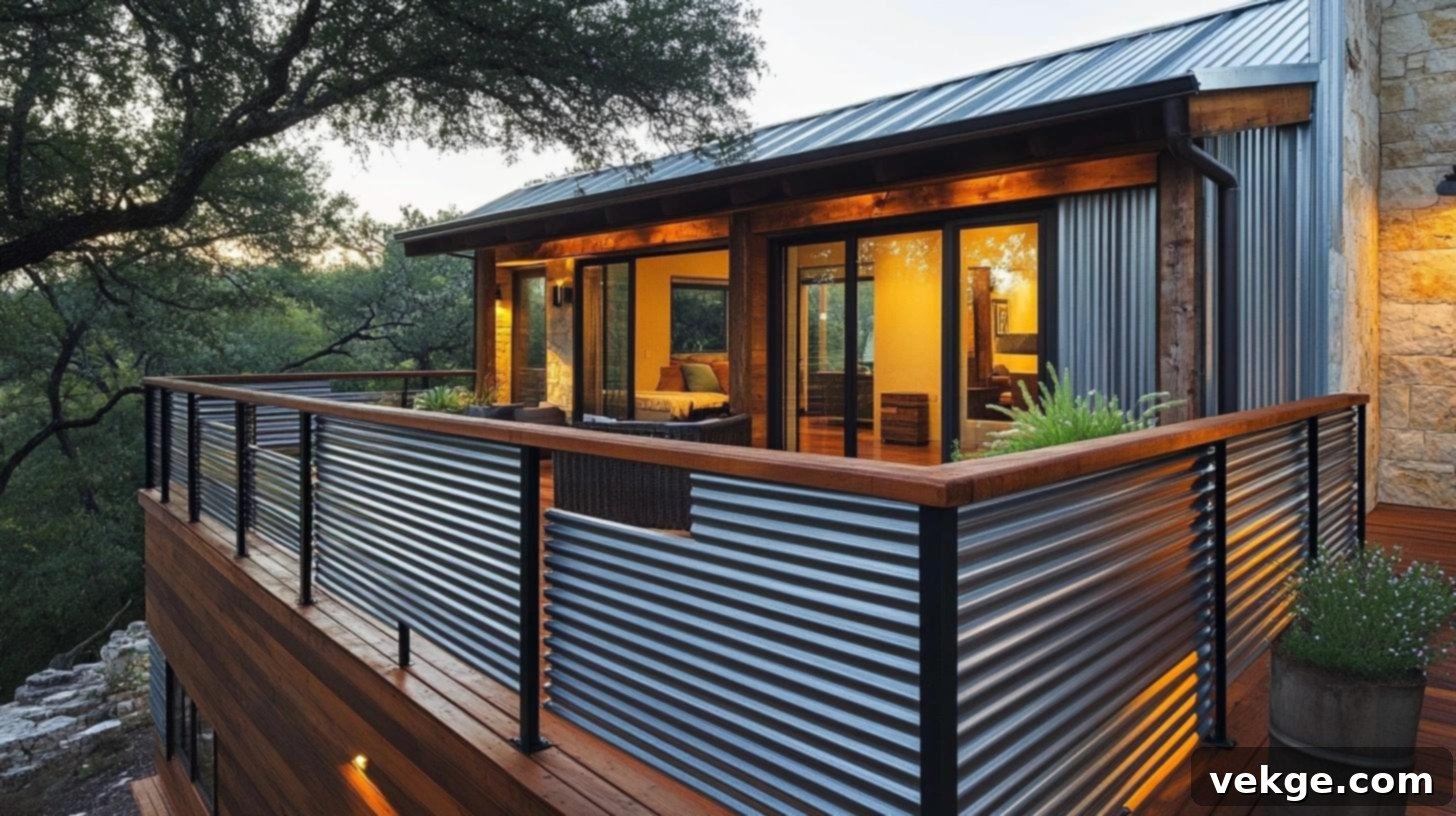
Wavy metal sheets, made from galvanized steel or aluminum, are installed horizontally to introduce unique texture and visual intrigue to your deck. The distinctive corrugated pattern catches the light at different angles, creating dynamic reflections that change throughout the day. This contemporary and robust choice is well-suited for modern homes, updated ranch styles, and industrial-inspired outdoor spaces, offering durability and a fresh look.
Cost: An affordable option at $90-180 per linear foot, including installation. The price will vary based on the metal type (aluminum often being lighter and more rust-resistant), gauge, and finish.
Benefits:
- Creates Interesting Light Patterns: The undulating surface of corrugated metal interacts beautifully with sunlight, generating captivating visual effects and adding character to your deck.
- Handles Harsh Weather Well: Galvanized steel and aluminum are exceptionally resilient against various weather conditions, including rain, snow, and strong winds, ensuring long-term performance.
- Needs Little Upkeep Over Time: This material is inherently low-maintenance, requiring minimal cleaning and no painting, making it a practical and durable choice for busy homeowners.
12. Metal Mesh Panels
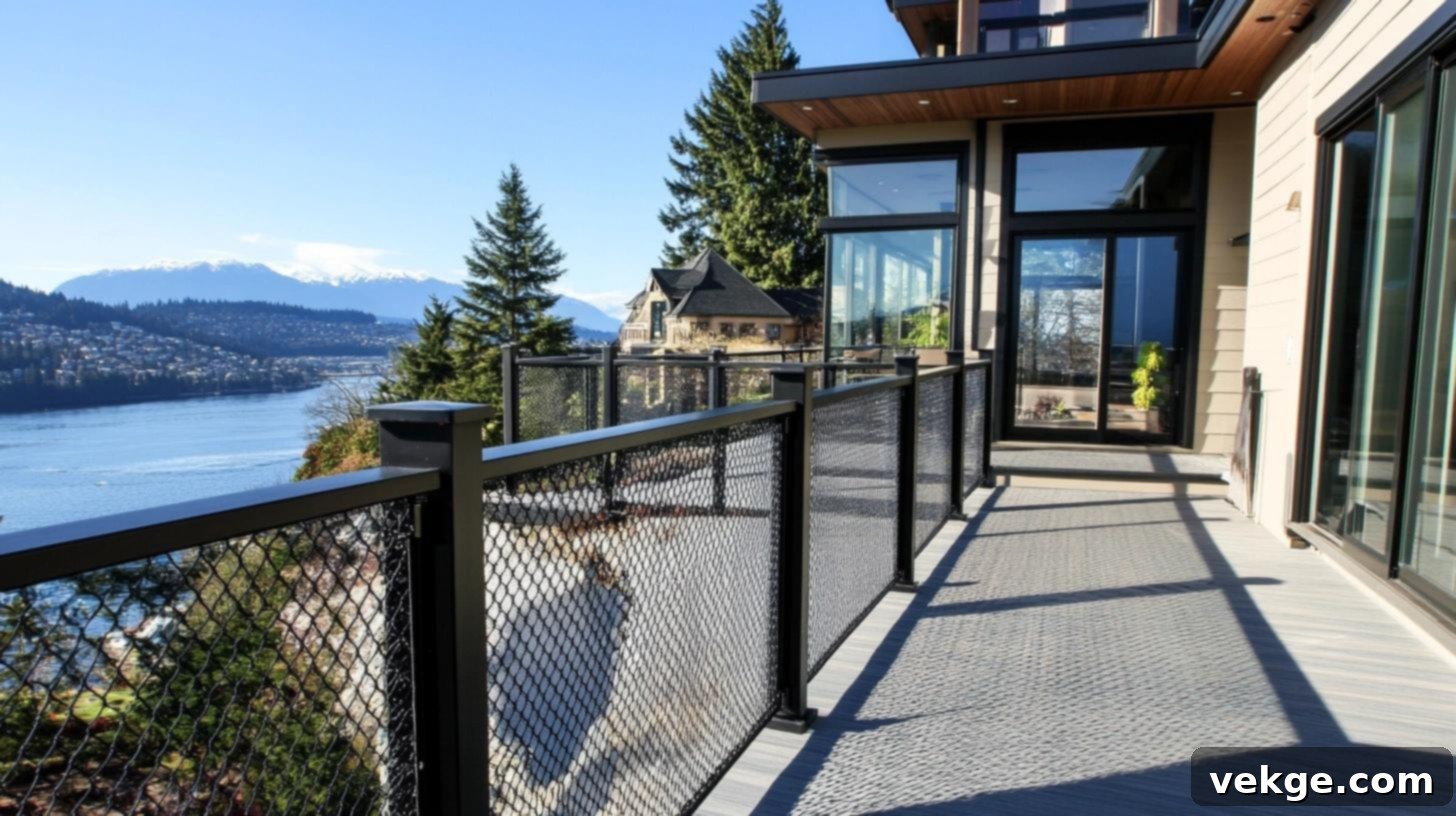
Woven steel mesh, stretched taut between frame posts, offers a secure barrier without significantly impeding your view. Available in a variety of patterns and mesh sizes, these panels often come in pre-made sections, simplifying the installation process. This contemporary and resilient style is perfectly suited for urban settings, modern architectural builds, and any space where security, visibility, and a clean aesthetic are desired.
Cost: Costs typically range from $100-200 per linear foot. Factors affecting the price include the mesh material (stainless steel being more expensive), weave density, and panel dimensions.
Benefits:
- Stops Small Objects from Falling: The tight weave of the mesh effectively prevents small items, children’s toys, or even pets from slipping through the railing, enhancing safety.
- Easy to Clean with Water Spray: Maintenance is straightforward; a simple spray with water is often sufficient to keep the mesh panels clean and free of debris.
- Maintains Full Visibility: Despite its strength, the woven mesh design allows for excellent transparency, preserving your outdoor views and contributing to an open-air feel.
13. Painted Steel Bars

Powder-coated steel bars introduce vibrant color to your deck while ensuring lasting protection and durability. These bars, finished with weather-resistant paint, are available in virtually any color to either perfectly match or boldly accent your home’s exterior. This option is ideal for homeowners looking to make a personalized and impactful statement, injecting personality and modern flair into their outdoor space.
Cost: A mid-to-high range option at $120-250 per linear foot. The cost is influenced by the thickness of the steel, the quality of the powder coating, and the complexity of the color application.
Benefits:
- Resists Fading and Chipping: The durable powder-coat finish is highly resistant to UV rays and physical impact, ensuring the color remains vibrant and intact for many years.
- Offers Endless Color Options: With an almost limitless palette, you can choose a color that perfectly harmonizes with your home or makes a bold, contrasting statement.
- Requires Minimal Touch-Ups: The robust finish significantly reduces the need for frequent maintenance or repainting, providing a long-lasting, attractive solution with little effort.
14. Tensioned Wire Railing
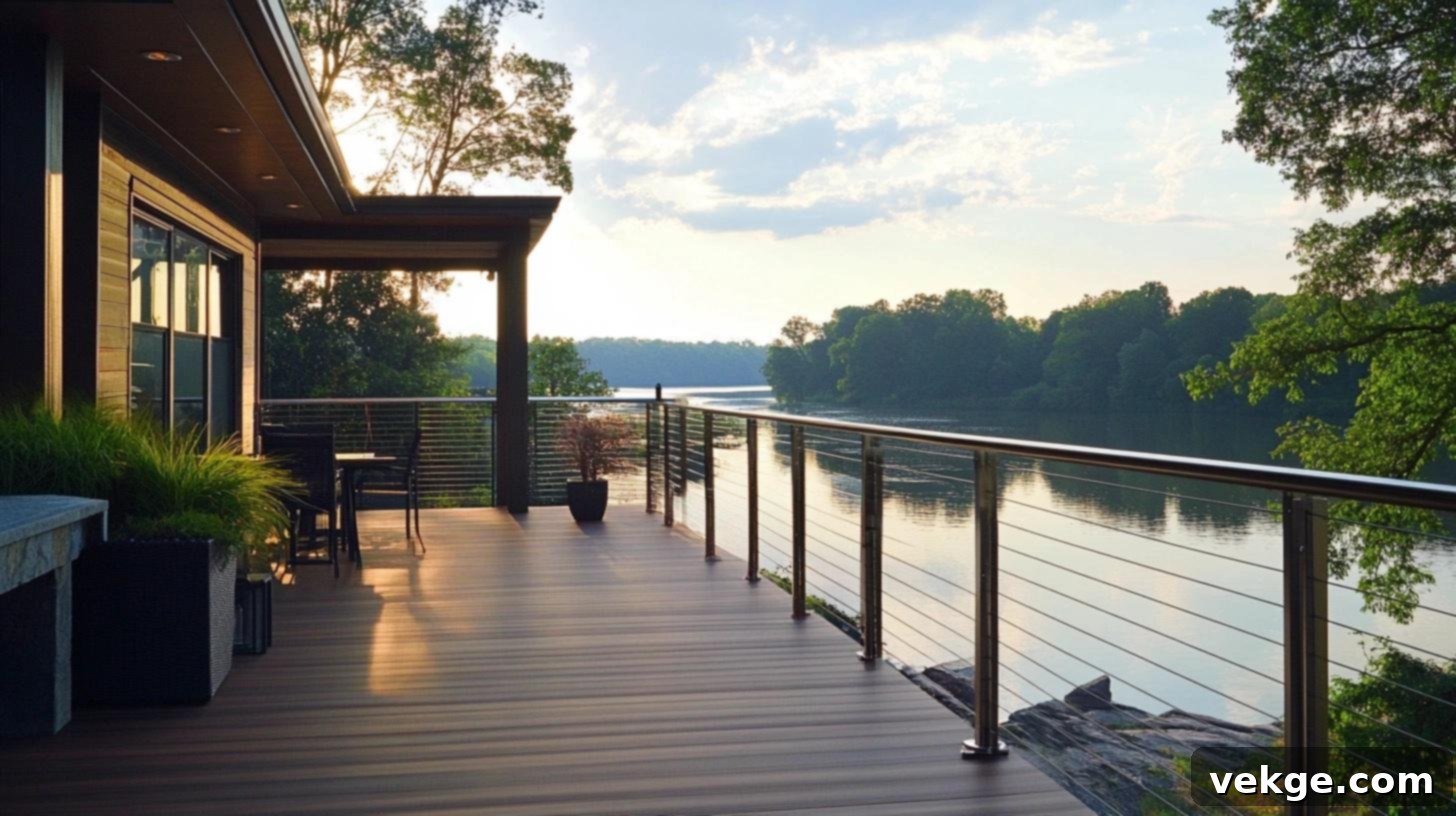
Ultra-thin stainless steel wires, typically measuring just 1/8 inch thick, run horizontally between sturdy end posts, creating an almost invisible barrier. These wires are pulled extremely tight with specialized tensioners, ensuring a taut, minimalist, and virtually unobstructed appearance. This sophisticated design excels in areas boasting scenic views, allowing the surrounding landscape to remain the undeniable focal point of your outdoor space.
Cost: A higher-end option, ranging from $130-280 per linear foot. This price reflects the precision engineering, high-quality stainless steel, and specialized installation techniques required for optimal tension and safety.
Benefits:
- Almost Invisible from a Distance: The slender wires blend seamlessly into the background, giving the impression of an open, unfettered space.
- Never Blocks Your View: Designed for maximum transparency, tensioned wire railings ensure that your beautiful outdoor vistas are completely preserved and enjoyed.
- Takes Up Minimal Space: The slim profile of the wires and posts creates a sense of airiness, preventing the railing from feeling bulky or encroaching on your deck’s usable area.
15. Frameless Glass Panels
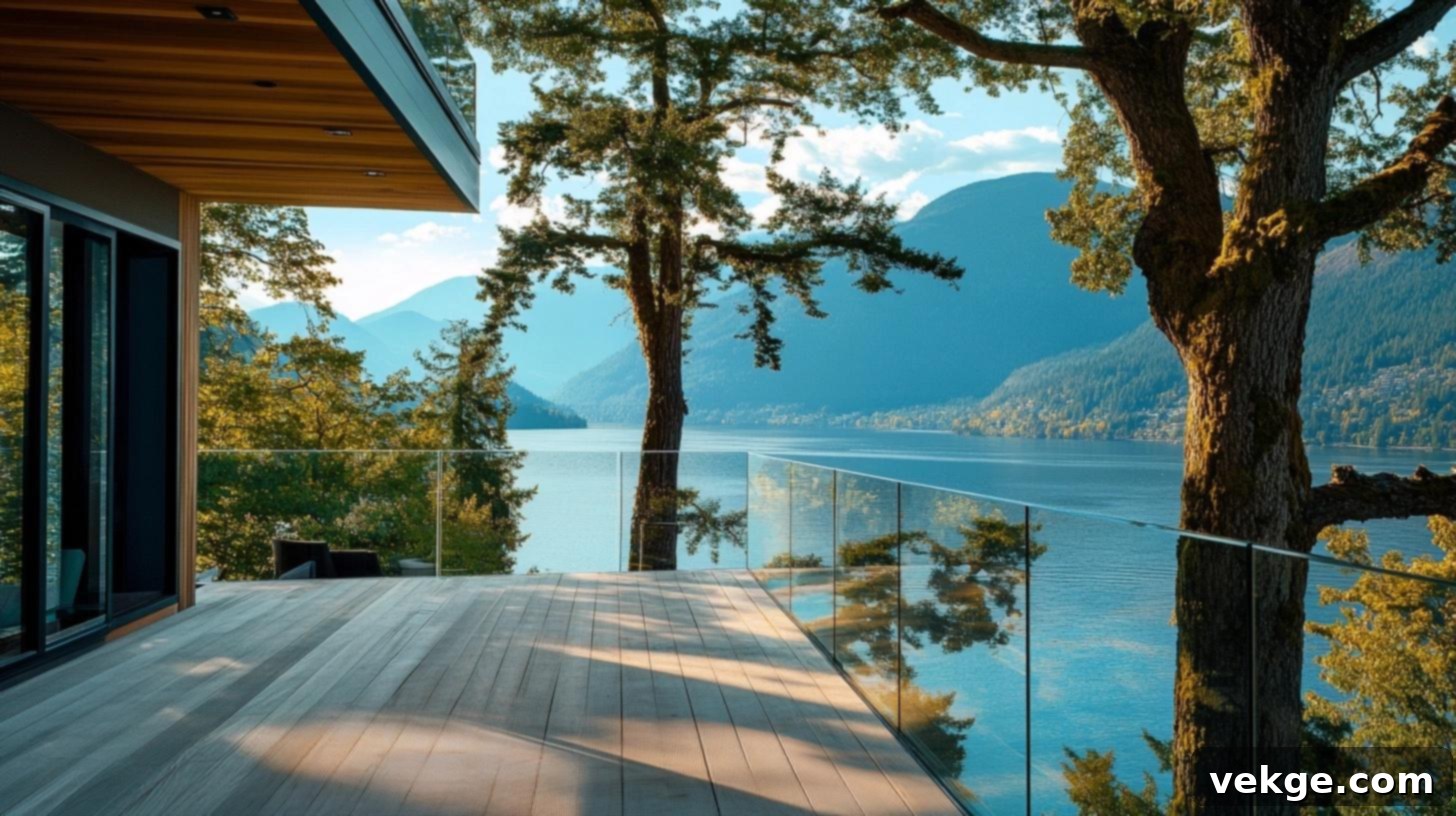
Edge-to-edge tempered glass panels, typically 1/2 inch thick, are secured with discreet, hidden brackets, forming a pristine, transparent protective wall. These panels sit flush between posts or are mounted directly, without any visible frames, achieving an ultra-modern and utterly unobstructed look. This premium style perfectly suits contemporary homes, luxury penthouses, and properties where an uncompromised view and a sense of expansive openness are paramount.
Cost: As a high-end, luxury option, frameless glass panels cost $250-400 per linear foot. The price reflects the thick, tempered glass, specialized mounting hardware, and expert installation needed for safety and aesthetic appeal.
Benefits:
- Looks Completely Unobstructed: The absence of frames creates a seamless, panoramic view, making your deck feel boundless and integrated with its surroundings.
- Stops Wind While Keeping Views: Offers effective wind protection, allowing you to enjoy your outdoor space comfortably, even on breezy days, without compromising visibility.
- Makes Spaces Feel Larger: The transparency of the glass visually extends your interior living space outwards, making both your deck and adjacent rooms appear more expansive and airy.
16. Decorative Wooden Lattice
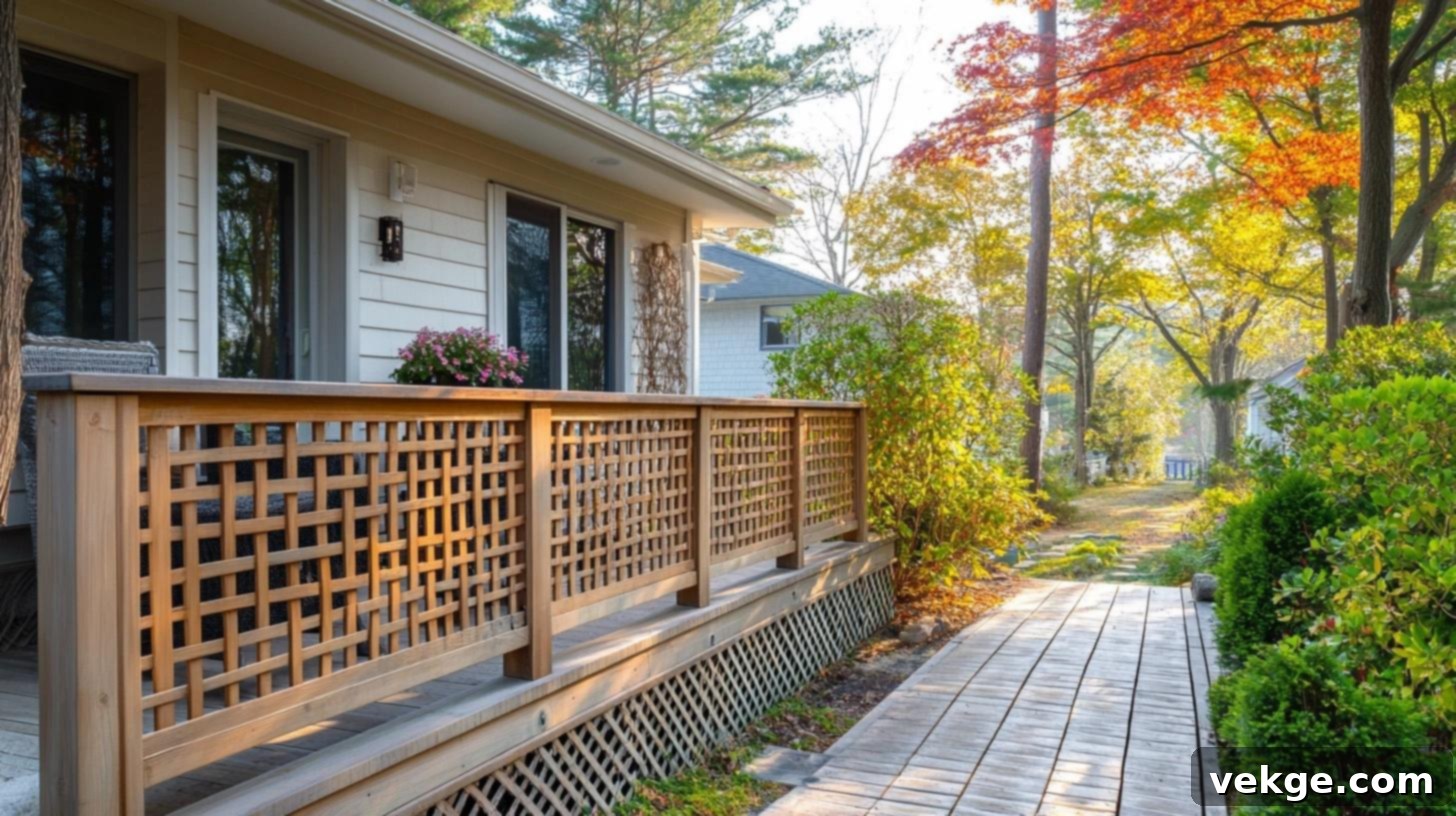
Thin wooden strips, usually 1/4-inch thick with 2-inch openings, are skillfully crossed horizontally to form charming, traditional patterns. This lattice design adds beautiful texture while ensuring ample airflow, creating a classic and inviting atmosphere. This versatile option fits exceptionally well with cottage-style homes, traditional country houses, and gardens, offering a touch of rustic elegance and a foundation for climbing plants.
Cost: An attractive mid-range option at $80-150 per linear foot, including installation. The cost can vary based on the type of wood (e.g., cedar, redwood), the intricacy of the lattice pattern, and the finish.
Benefits:
- Forms Pretty Light Patterns: As sunlight passes through the lattice, it creates beautiful, dappled light and shadow patterns on your deck, enhancing its visual appeal.
- Supports Climbing Plants: The open structure of the lattice provides an ideal framework for climbing vines and flowering plants, allowing you to incorporate lush greenery into your railing design.
- Offers Partial Privacy: The patterned design provides a degree of screening, offering partial privacy while still allowing light and air to pass through, creating a cozy yet open feel.
17. Barnwood Planks

Reclaimed wood, sourced from old barns and historic buildings, brings an unparalleled sense of history and character to your deck’s border. Each plank, weathered by decades of exposure, showcases unique grain patterns, color variations, and charming imperfections from its past life. This authentic style perfectly complements country homes, rustic mountain retreats, and any space aiming for a truly unique, vintage, and sustainable aesthetic.
Cost: A moderate to high-end option at $90-175 per linear foot. The cost reflects the scarcity and unique character of reclaimed wood, as well as the preparation and installation required.
Benefits:
- Each Piece Tells a Story: Every plank of barnwood carries a rich history, adding an undeniable narrative and depth to your deck that new materials cannot replicate.
- Ages Naturally Over Time: Barnwood continues to age gracefully, developing an even richer patina and character over the years, enhancing its rustic appeal.
- Uses Sustainable Materials: Choosing reclaimed barnwood is an eco-conscious decision, repurposing existing resources and reducing demand for new lumber, promoting environmental sustainability.
18. Mosaic Glass Panels
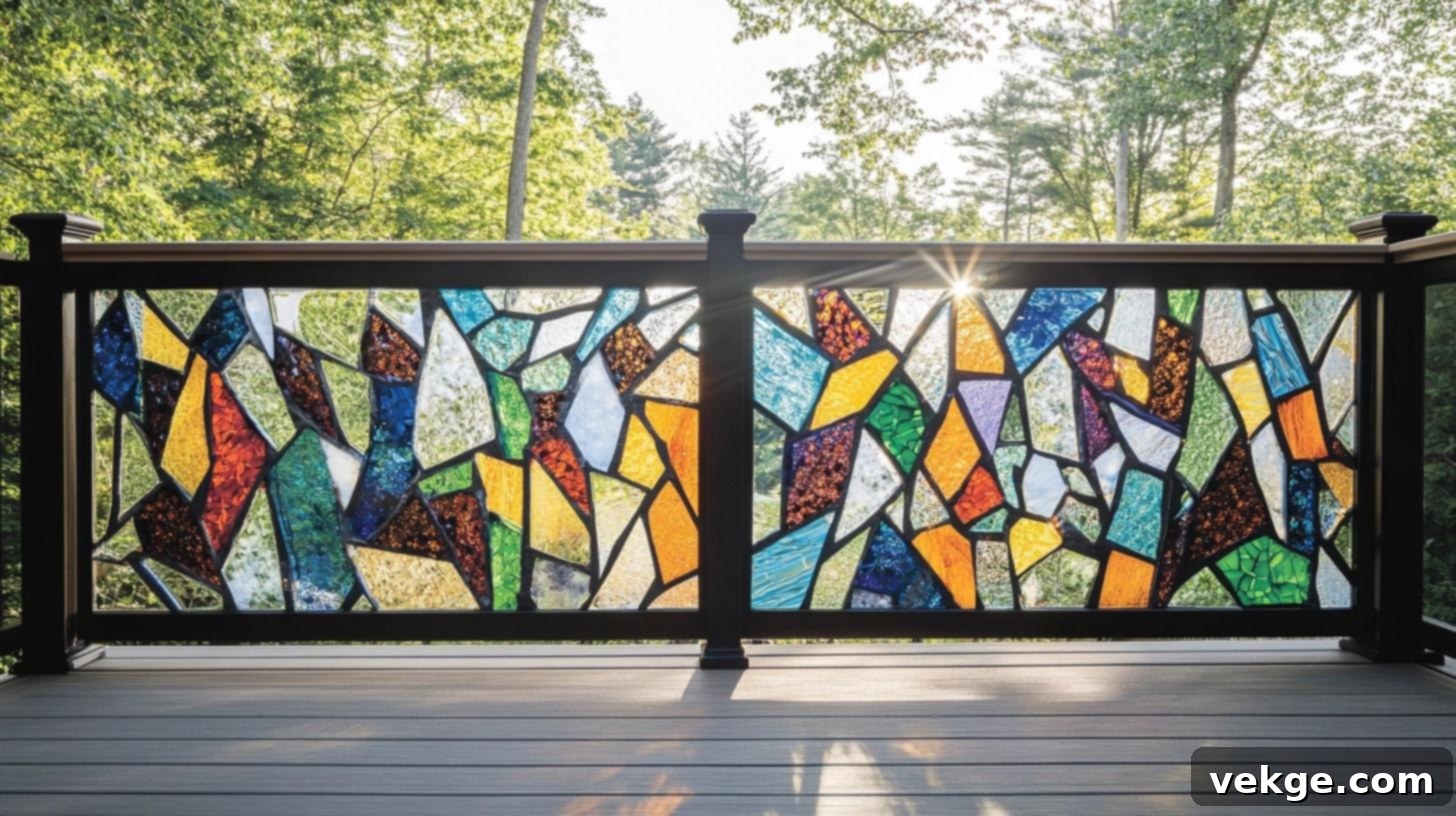
Small, vibrantly colored glass pieces are meticulously set into weather-proof frames to create stunning, light-refracting effects. These panels, crafted from tempered glass bits, form intricate patterns that shimmer and glow when illuminated by sunlight, casting beautiful colored light onto your deck. This artistic design is perfectly suited for creative homes, meditation spaces, and anyone looking to infuse their outdoor area with a unique, jewel-toned radiance and personalized artistry.
Cost: A premium choice, ranging from $220-400 per linear foot. The cost reflects the artisanal craftsmanship, custom design, specialized glass, and expert installation needed for these decorative panels.
Benefits:
- Sparkles in Sunlight: The individual glass pieces catch the light, creating a dazzling, kaleidoscopic display that constantly shifts with the sun’s movement.
- Makes Each Deck Unique: Custom mosaic patterns ensure that your deck railing is an exclusive work of art, reflecting your personal style and creativity.
- Changes with Lighting: The appearance of the mosaic panels transforms throughout the day, offering different visual experiences from bright, vibrant colors in daylight to subtle glows at dusk.
19. Frosted Glass Panels
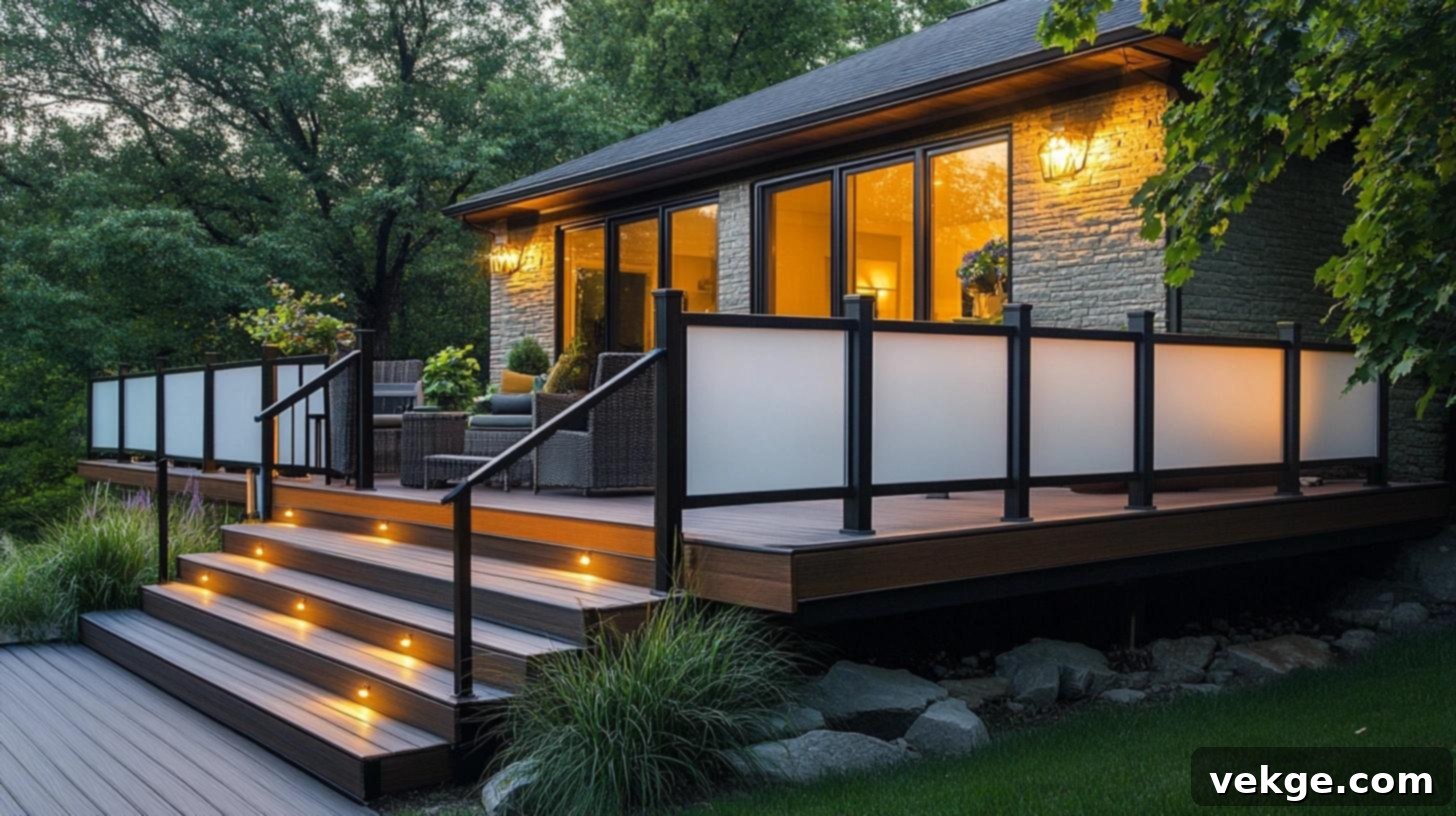
Sandblasted glass panels, typically 1/2 inch thick, form a soft, diffused barrier that allows light to pass through while elegantly obscuring clear views, providing subtle privacy. These panels create a gentle glow, especially at night, adding a serene and sophisticated ambiance. This modern option works exceptionally well for urban decks, spaces requiring discreet screening from neighbors, and contemporary designs where a soft, luminous aesthetic is desired.
Cost: A high-end investment at $200-350 per linear foot. This pricing reflects the specialized sandblasting process, high-quality tempered glass, and professional installation.
Benefits:
- Glows Softly at Night: When illuminated, frosted glass panels diffuse light beautifully, creating a gentle, inviting glow that enhances evening ambiance without harsh brightness.
- Hides Marks and Smudges: The textured surface of frosted glass is less prone to showing fingerprints, smudges, and dirt compared to clear glass, making it easier to maintain a clean appearance.
- Maintains Bright Spaces: While offering privacy, frosted glass still allows ample natural light to penetrate, ensuring your deck remains bright and airy without feeling enclosed.
20. Decorative Iron Panels
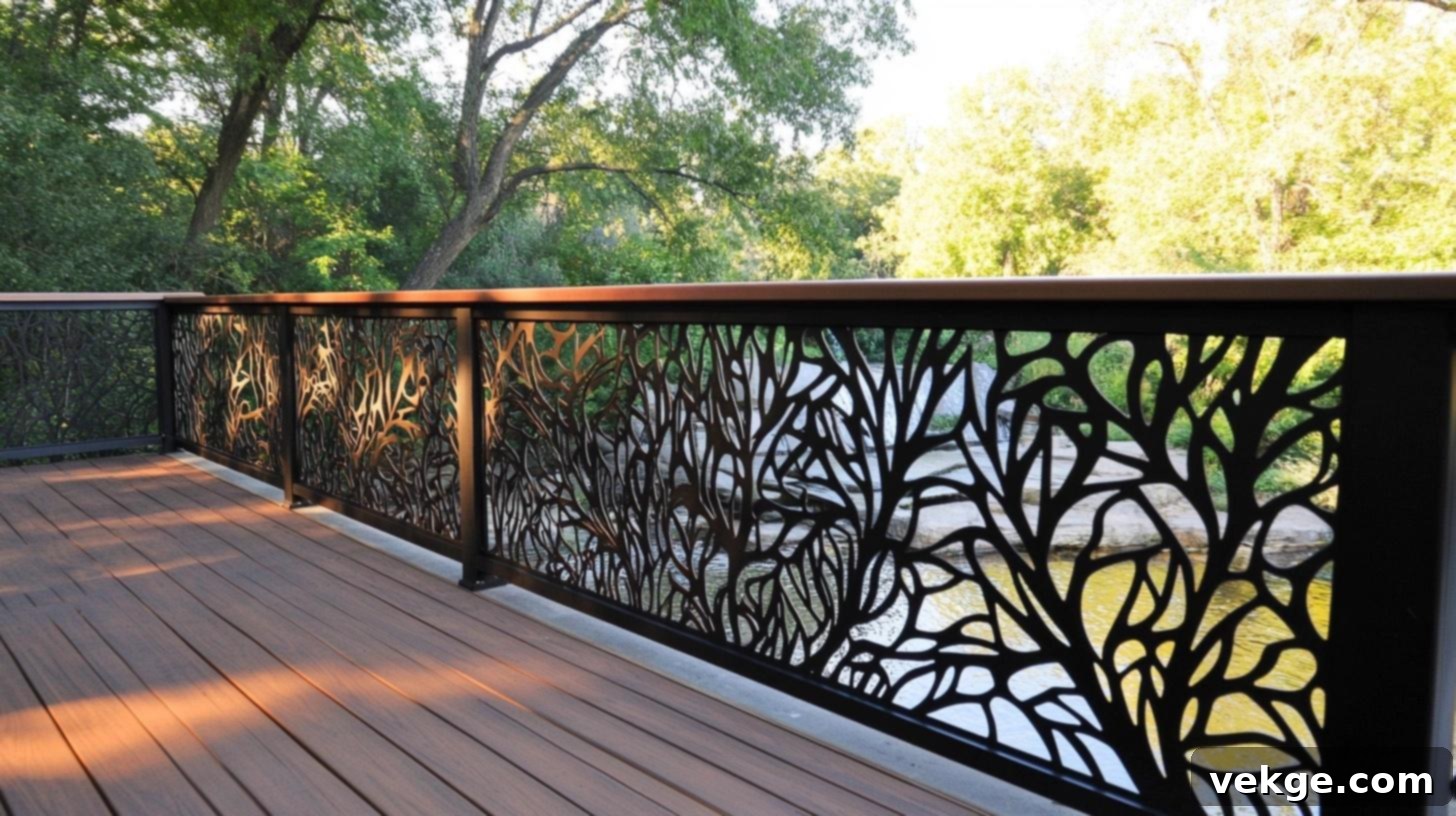
Hand-crafted iron panels, typically made from 1/2-inch iron bars, feature custom patterns and intricate designs between posts, showcasing exquisite artistry. These unique panels not only serve as a sturdy barrier but also cast captivating shadows, adding a dramatic and elegant dimension to your deck. This timeless style is perfectly suited for historic homes, custom-built properties, and homeowners seeking a truly bespoke, enduring, and visually stunning railing solution.
Cost: A premium, custom option at $200-400 per linear foot. The cost is high due to the specialized metalworking, custom design, intricate fabrication, and professional installation required for each unique piece.
Benefits:
- Offers One-of-a-Kind Patterns: Each iron panel can be custom-forged, allowing for unique, personalized designs that make your deck railing a distinctive architectural feature.
- Lasts for Generations: Wrought iron is renowned for its incredible durability and longevity, capable of withstanding the elements for many decades with proper care.
- Increases Property Value: The aesthetic appeal and robust quality of decorative iron railings add significant curb appeal and can enhance the overall value of your home.
21. Black Steel Flat Bar
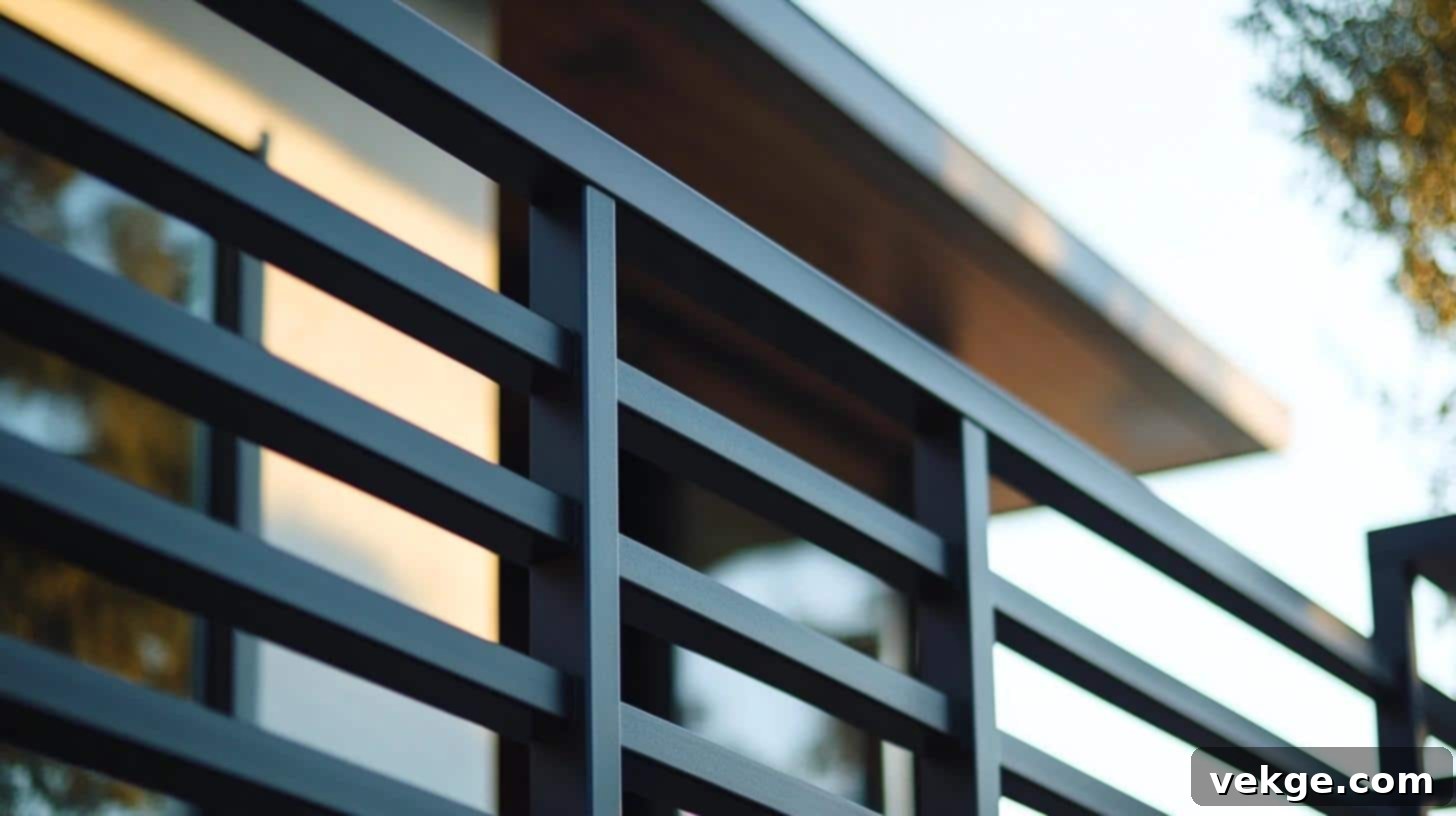
Wide, flat steel bars, measuring approximately 2 inches wide and 1/4 inch thick, are precisely welded to posts to create bold, clean horizontal lines with a sophisticated matte black finish. This design ensures a seamless, modern look with no visible weld marks, emphasizing its minimalist elegance. This striking style works perfectly with industrial aesthetics, contemporary designs, and modern farmhouses, providing a powerful visual statement and robust security.
Cost: A mid-to-high range option at $150-270 per linear foot. The cost reflects the quality of steel, the specialized welding process for a seamless look, and the durable matte black powder coating.
Benefits:
- Makes a Strong Statement: The bold, flat profile and matte black finish create an undeniable visual impact, asserting a confident and contemporary presence.
- Shows No Weld Marks: The expert welding and finishing techniques ensure a smooth, continuous surface, enhancing the clean and polished aesthetic of the railing.
- Contrasts with Light Walls: The dark, solid lines of the steel flat bars create a dramatic and beautiful contrast against lighter exterior walls, highlighting architectural features.
22. Horizontal Rebar
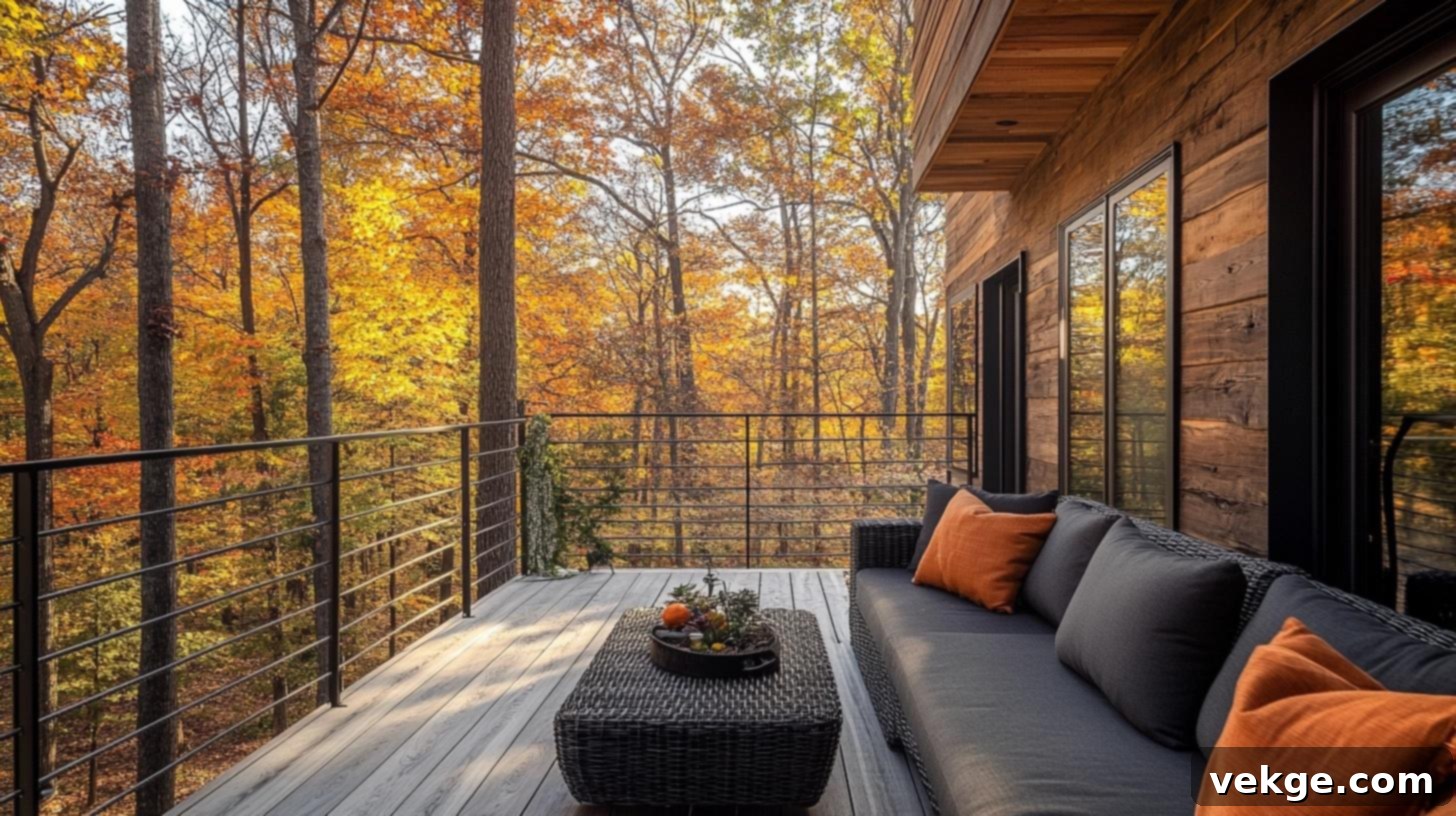
Construction-grade rebar, typically 1/2 inch thick, is arranged in horizontal rows and securely welded to metal posts, forming a strong and distinctive barrier. The inherent ruggedness and industrial texture of rebar provide a unique, raw aesthetic. This robust design matches exceptionally well with concrete and steel architecture, modern industrial lofts, and experimental outdoor spaces, offering maximum strength and an unconventional charm.
Cost: An surprisingly economical option, ranging from $50-100 per linear foot. The affordability comes from using readily available construction materials, though welding costs should be factored in.
Benefits:
- Provides Maximum Durability: Rebar is engineered for structural strength, making it an incredibly durable and long-lasting material for deck railings, capable of resisting significant force.
- Costs Less Than Standard Metal Rails: Utilizing rebar can be a more budget-friendly alternative to custom-fabricated metal railings, offering a cost-effective industrial look.
- Supports Heavy-Weight Loads: Its inherent strength means rebar can handle considerable weight, making the railing extremely stable and safe under various conditions.
23. Mixed Material Layers
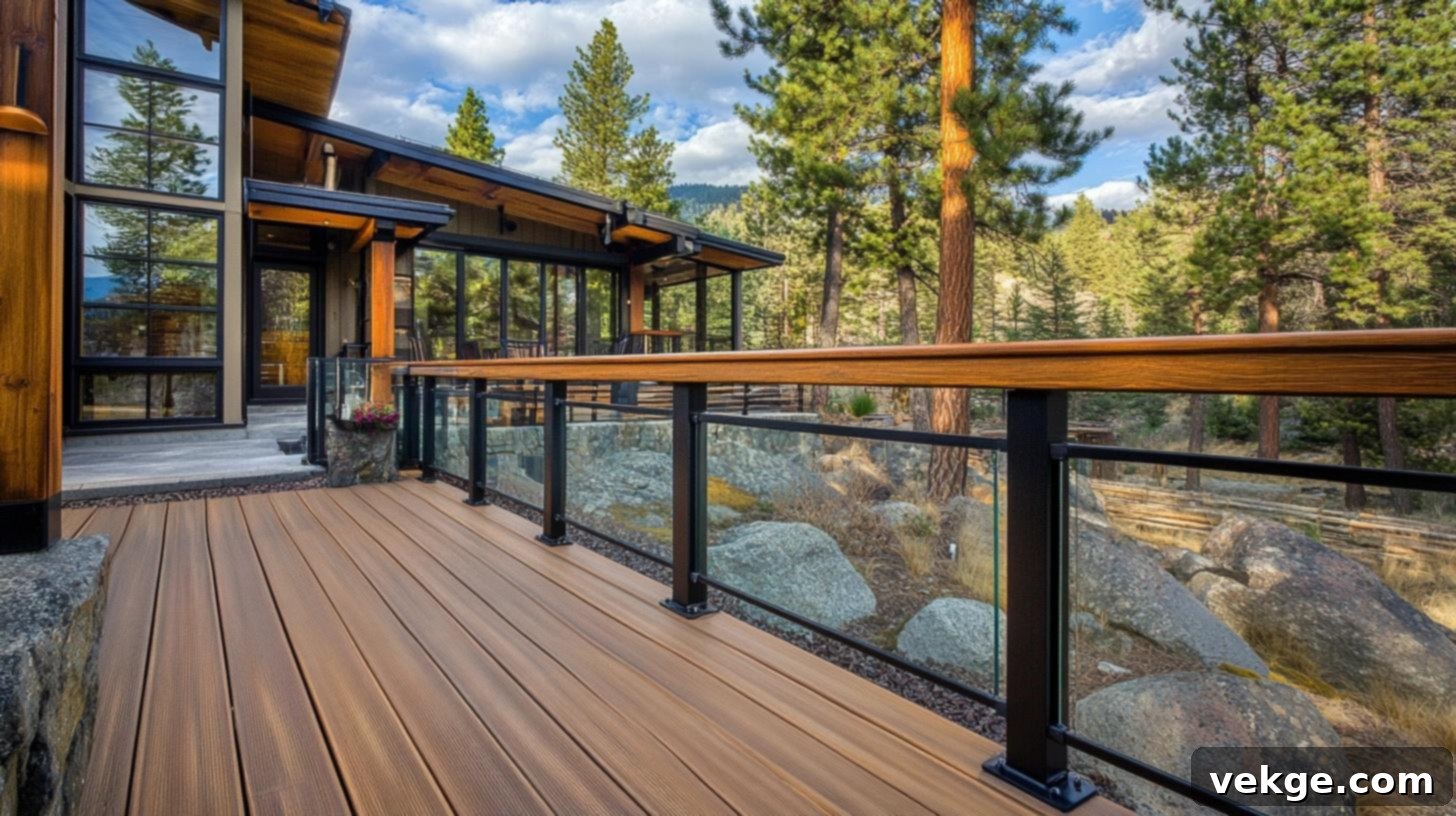
This innovative design integrates a captivating combination of wood boards, metal sections, and glass pieces, creating remarkable depth through thoughtful layering. Each material is positioned at a different depth from the supporting posts, typically with wood closest, metal in the middle, and glass panels facing outwards. This multi-dimensional approach introduces rich texture and visual complexity. This design works best for larger decks where the intricate patterns and layered effects can be fully appreciated and make a grand statement.
Cost: As a complex and custom option, expect costs of $200-350 per linear foot. The price reflects the multiple materials, intricate design, precision fabrication, and specialized installation for each layer.
Benefits:
- Creates Unique Shadow Effects: The varying depths of the materials interact dynamically with sunlight, casting interesting and ever-changing shadow patterns on your deck surface.
- Lets You Feature Multiple Textures: This design allows you to showcase the distinct tactile and visual qualities of different materials simultaneously, enriching the deck’s aesthetic.
- Makes Your Deck Stand Out: The sophisticated layering and material combination result in a truly distinctive railing that becomes a bespoke architectural feature, guaranteeing your deck leaves a lasting impression.
24. Painted Wood Slats
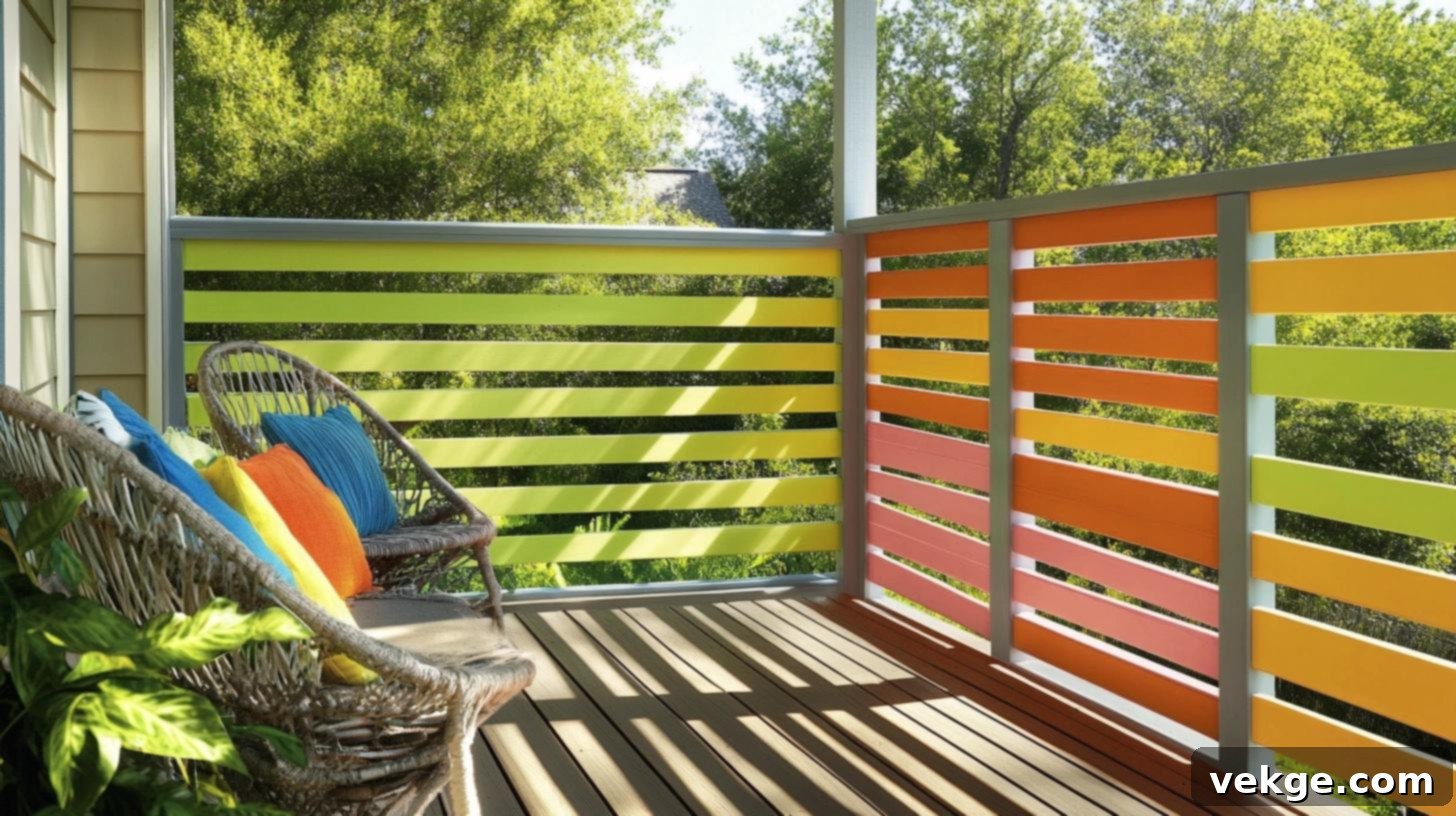
Standard wooden boards, typically 4 inches wide, are finished with durable exterior paint to infuse your outdoor space with bright personality and customizable charm. These slats can be painted in a single vibrant color for a bold statement or adorned with playful patterns for a more whimsical touch. This versatile design is particularly suitable for beach houses, family-friendly spaces, and any homeowner looking to inject unique character and a cheerful aesthetic into their deck.
Cost: A cost-effective option at $70-130 per linear foot. The price varies based on the type of wood (e.g., pressure-treated, cedar), the quality of the paint, and the labor involved in painting multiple coats for durability.
Benefits:
- Changes Look with New Paint: The ability to easily repaint means you can refresh your deck’s aesthetic to match new trends or your evolving personal style without a complete overhaul.
- Brightens Outdoor Spaces: A well-chosen paint color can dramatically lighten and enliven your deck, making it feel more inviting and expansive.
- Matches Any Color Scheme: With an endless array of paint colors, you can perfectly coordinate your railing with your home’s exterior, garden, or outdoor furniture, creating a cohesive look.
25. Rustic Log Railings
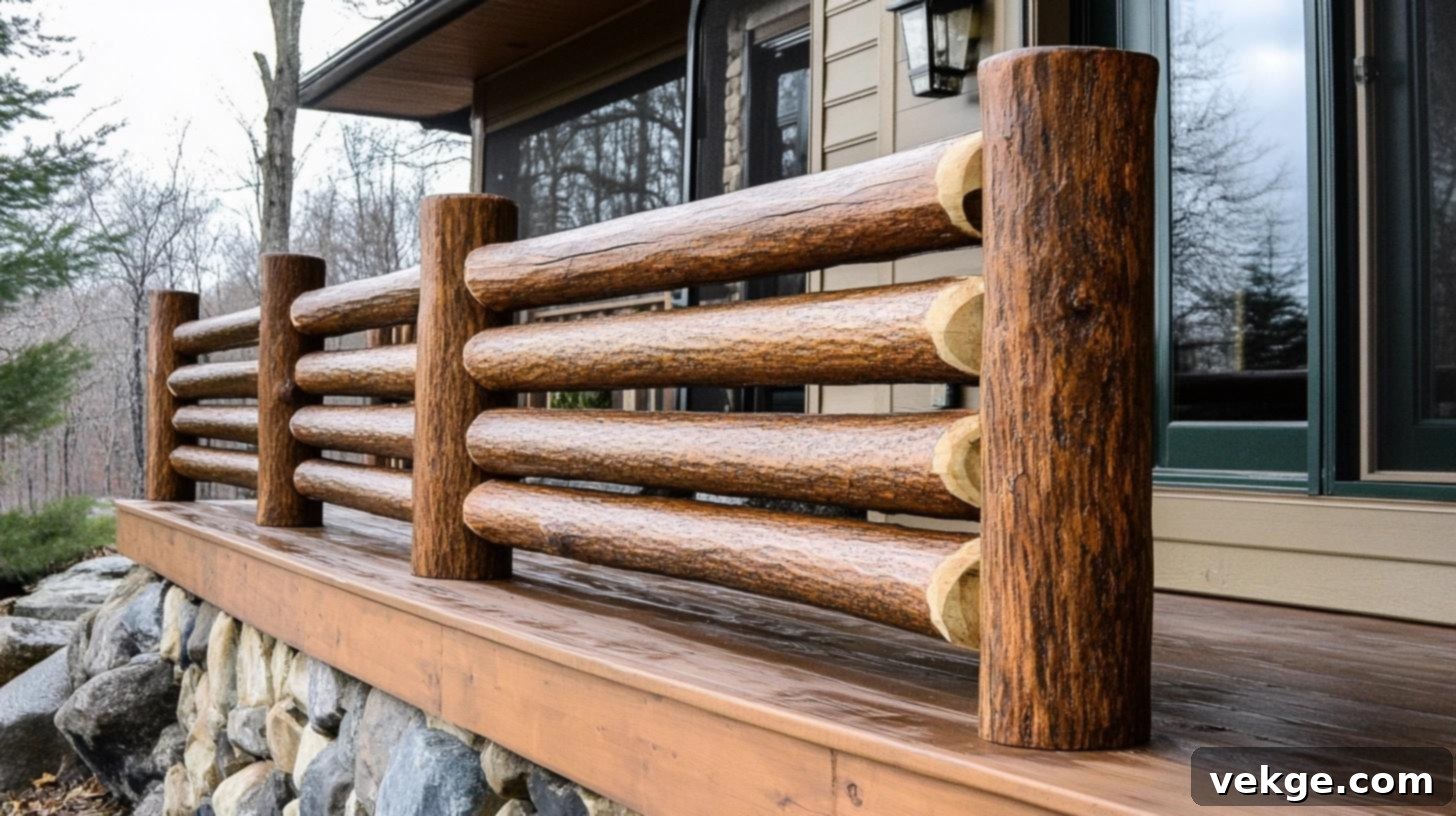
Split logs, cut to approximately 4-6 inches in diameter, are robustly mounted side by side to bring the untamed beauty of nature directly to your deck. These logs retain their natural bark and distinctive character marks, each telling a unique story of its origin. This authentic option fits perfectly with mountain homes, woodland settings, cabins, and any property aiming for a truly organic, rugged, and profoundly natural aesthetic that harmonizes with its environment.
Cost: A moderate investment at $85-160 per linear foot. The cost is influenced by the type of wood (e.g., cedar, pine), the diameter of the logs, and the complexity of the custom fitting and securing process.
Benefits:
- Shows Natural Wood Patterns: The unrefined beauty of the logs, with their unique bark textures and grain, creates an unparalleled rustic charm and organic visual appeal.
- Gets Better with Age: As the logs naturally weather over time, they develop a rich patina that enhances their rustic character and deepens their connection to the natural landscape.
- Feels Solid and Stable: The substantial size and natural strength of logs provide an incredibly solid and stable railing, instilling a sense of robust security and enduring quality.
Step-by-Step DIY Guide to Building Horizontal Deck Railings
Embarking on a DIY deck railing project can be a rewarding experience, allowing you to customize your outdoor space to your exact specifications. This guide will walk you through the process of building simple, yet stylish, horizontal wood slat railings.
Tools & Materials Table
| Tool/Material | Description | Cost (Approximate) |
|---|---|---|
| 1×6 Boards | Versatile wooden boards, commonly used for creating the horizontal slat patterns. Opt for pressure-treated lumber or naturally resistant wood like cedar for longevity. | $6-$10 per board (depending on wood type and length) |
| Microfiber Pads | Essential for smooth, even application of stain or sealer, ensuring a professional finish without streaks or brush marks. | $5 per pad (pack of several often more economical) |
| Driftwood Gray Stain | A semi-transparent stain that provides a weathered, rustic finish while protecting the wood from UV damage and moisture. Choose a high-quality exterior grade. | $20 per can (covers approximately 150-200 sq ft) |
| 23-Gauge Pin Nailer | A small, precise nail gun ideal for discreetly securing wooden boards without leaving large holes, perfect for a clean aesthetic. | $100-$200 (can be rented for shorter projects) |
| 18-Gauge Brad Nailer (optional) | A slightly larger nail gun that offers added holding power for boards, suitable if you desire extra reinforcement, though leaving slightly larger holes. | $50-$100 (more affordable, often a good all-around tool) |
| Exterior Grade Wood Glue | Provides additional strong adhesion for securing boards, significantly enhancing the durability and stability of your railing over time. | $5-$10 per bottle (choose waterproof or exterior grade) |
| Sandpaper | Used to smooth out rough edges and surfaces on the wooden boards before staining, ensuring a splinter-free and aesthetically pleasing finish. Available in various grits. | $10 for a pack (assorted grits recommended) |
| Chop Saw (Miter Saw) | A power saw crucial for making precise, straight, and angled cuts on your wooden boards, ensuring accurate lengths for each slat. | $150-$300 (essential for professional-looking cuts; rental options available) |
| Spacers | Small pieces of scrap wood, cut to a consistent thickness (e.g., ¼ inch), used to maintain even gaps between horizontal boards for a uniform look. | DIY (Cost-free – use off-cuts from your boards) |
| Level | An indispensable tool to ensure all your horizontal boards are installed perfectly straight and parallel, critical for both aesthetics and structural integrity. | $10-$20 (a good quality 2-foot or 4-foot level is ideal) |
Step 1: Cut and Prepare the Boards
- Begin by carefully “ripping down” your 1×6 boards to your desired width for the horizontal slats. For example, you might cut a 1×6 into two 1x3s. Precision here is key for a uniform look.
- Once cut, thoroughly sand each board to eliminate any rough edges or splinters. This not only ensures a smooth, clean surface for staining but also makes the railing safer to touch.
Step 2: Stain the Boards
- Apply your chosen Driftwood Gray stain (or any other exterior-grade stain) evenly to all sides of each board using microfiber pads. Work in a well-ventilated area.
- Ensure complete coverage for optimal protection and aesthetic uniformity. Allow the stain to dry completely according to the manufacturer’s instructions before proceeding to the next steps. This might take 24-48 hours depending on humidity.
Step 3: Select and Cut to Size
- Inspect each stained board and select the “best face” – the side with the most appealing grain and fewest imperfections – as this will be the visible surface.
- Measure the distance between your deck posts accurately and cut each board to the appropriate length using your chop saw. Measure twice, cut once!
Step 4: Remove Old Spindles and Set the First Board
- If retrofitting, carefully remove any existing vertical spindles. You might choose to leave some for additional structural support if they don’t interfere with your horizontal design.
- Begin installing your new horizontal slats, starting with the very top board. It is absolutely crucial that this first board is perfectly level, as it will serve as the reference point for all subsequent boards. Use your level frequently.
Step 5: Create and Use Spacers
- Cut several pieces of scrap wood to your desired spacing thickness, for instance, approximately ¼ inch, to serve as consistent spacers.
- These spacers are invaluable for ensuring uniform gaps between each horizontal board, creating a professional and aesthetically pleasing rhythm throughout your railing.
Step 6: Attach Boards with Nailer and Glue
- Place your first board and secure it using a 23-gauge pin nailer. For enhanced durability and long-term hold, apply a thin bead of exterior-grade wood glue along the contact points with the posts before nailing.
- Place your spacers, then position the next board, ensuring it’s level, and secure it. Continue this process, checking alignment and levelness as you move down the railing section.
Step 7: Final Fit and Finish
- For the last board in each section, you may need to trim it precisely to fit any remaining space.
- Once all boards are installed, step back and visually inspect the entire railing section for alignment and consistency. Repeat the entire process for all remaining railing sections on your deck. Utilize any off-cuts or smaller pieces for shorter sections or to fill small gaps where appropriate.
Smart Care Guide for Deck Railings

Proper maintenance is crucial for extending the lifespan and preserving the aesthetic appeal of your horizontal deck railings. Different materials demand specific care routines to remain strong, safe, and visually appealing. Here’s a comprehensive guide to maintaining each type of railing:
Metal Railings (Steel, Aluminum, Wire)
- Regular Inspections: Every 6 months, meticulously check the tension of all wires, the tightness of bolts, and the security of fasteners. Re-tension cables or tighten bolts as needed to prevent sagging and ensure structural integrity.
- Routine Cleaning: Twice yearly, wipe down all metal surfaces with a mild soap solution (e.g., dish soap and water) and a soft cloth to remove dirt, grime, and environmental pollutants. Rinse thoroughly with clean water to prevent soap residue buildup.
- Rust Prevention: Vigilantly watch for any signs of rust spots, especially on steel railings. Treat them immediately with a wire brush and rust-inhibiting primer/paint. In coastal areas or regions with high humidity, apply specialized metal protectants annually to create a barrier against corrosive elements.
- Protective Coatings: For powder-coated or painted metal railings, inspect for chips or scratches. Touch up with matching exterior paint to prevent rust and maintain appearance.
Wooden Railings
- Annual Cleaning: Each spring, thoroughly clean your wooden railings using a dedicated wood cleaner or a gentle solution of mild soap and water with a soft brush or a low-pressure washer. Avoid high-pressure settings which can damage wood fibers.
- Sealing and Staining: Every 2-3 years, or as recommended by the product manufacturer, reapply a fresh coat of wood sealer or stain. This protects the wood from UV damage, moisture, and prevents warping, cracking, and decay. Ensure all sides of the wood are sealed for comprehensive protection.
- Prompt Repairs: Immediately address any loose boards, protruding nails, or small cracks. Fill cracks with exterior wood filler and secure loose components to prevent them from worsening and compromising safety.
- Pest and Rot Checks: Regularly inspect for signs of insect infestation or wood rot, especially at the base of posts and where wood meets the ground or other materials.
Glass Panels
- Monthly Cleaning: Clean glass panels monthly with a high-quality glass cleaner and a microfiber cloth to prevent streak marks and remove smudges, dirt, and water spots. For stubborn grime, a gentle scrubber designed for glass can be used.
- Gasket and Seal Inspection: Annually, inspect all rubber gaskets, seals, and spacers around the glass panels for signs of wear, cracking, or deterioration. Damaged seals can allow water infiltration or compromise the panel’s stability.
- Drainage Maintenance: Keep drain holes (if present in the framing) clear of dirt, leaves, and debris to ensure proper water runoff and prevent pooling that can stain or damage components.
- Hardware Tightening: Periodically check and tighten any loose fittings, clamps, or mounting hardware that secure the glass panels. Loose hardware can lead to instability and potential safety hazards.
PVC and Composite Railings
- Semi-Annual Washing: Wash PVC and composite railings with mild soap and water twice yearly to remove dirt, pollen, and mildew. A soft brush or sponge is usually sufficient.
- Mold and Mildew Removal: If mold or mildew spots appear, promptly clean them with a specialized composite deck cleaner or a diluted bleach solution (following manufacturer instructions) to prevent spreading and staining.
- Pre-Winter Inspection: Before winter sets in, perform a thorough inspection for any loose sections or components. Ensure everything is securely fastened to withstand winter weather conditions, especially freeze-thaw cycles.
- Heat Avoidance: Keep materials away from direct heat sources like grills, fire pits, or extreme reflected sunlight, as excessive heat can cause warping or discoloration in PVC and composite materials.
General Tips for All Railing Types
- Regular Debris Clearance: Consistently clear snow, leaves, dirt, and other debris from your railings and surrounding deck surface. Accumulated organic matter can trap moisture and accelerate material degradation.
- Prevent Plant Growth: Trim back any climbing plants, vines, or overhanging branches that are growing on or near your railings. Plants can retain moisture, cause staining, and provide hiding spots for pests.
- Monitor Post Stability: Periodically check the stability of all deck posts. Wobbling or loose posts indicate a structural issue that needs immediate attention. Address small problems promptly before they escalate into major, costly repairs.
- Avoid Harsh Chemicals: Unless specifically recommended for your railing material, avoid using abrasive cleaners, harsh chemicals, or high-pressure washers, as these can damage finishes, protective coatings, or the material itself.
Conclusion
Throughout this comprehensive guide, we’ve explored how horizontal deck railings transcend their functional role of ensuring safety. They are powerful design elements capable of completely transforming your outdoor living space into a modern, stylish, and highly functional extension of your home. We’ve showcased a vast array of options, catering to every budget and aesthetic preference – from budget-friendly PVC railings starting at around $40 per linear foot, offering practical durability, to exquisite custom ironwork and frameless glass panels that can reach upwards of $400 per linear foot, providing unparalleled luxury and bespoke artistry.
We’ve meticulously detailed how each horizontal railing option brings unique benefits, whether it’s the expansive, clear views offered by sleek glass panels, the warm, inviting ambiance of traditional wooden slats, or the industrial chic of metal pipes. Understanding these differences empowers you to make an informed decision that aligns perfectly with your lifestyle, design aspirations, and practical needs.
Feeling inspired and ready to embark on your deck railing project? We strongly recommend starting by thoroughly checking your local building codes and assessing your existing deck structure. These initial steps are vital for ensuring compliance and the structural integrity of your upgrade. Take photos of your current space, gather images of your favorite designs, and consult with local contractors who specialize in deck construction and railing installation. Their expertise can help bring your vision to life safely and efficiently.
Have you experimented with any of these horizontal railing styles on your own deck? We’d love to hear about your experiences, challenges, and successes. Share your thoughts, tips, or any questions you might have in the comments section below – your insights could be incredibly valuable to other homeowners embarking on their own deck transformation journeys!
Frequently Asked Questions About Horizontal Deck Railings
Are Horizontal Deck Railings Safe for Homes with Children and Pets?
Yes, absolutely, horizontal deck railings can be very safe for homes with children and pets when installed correctly. The critical factor is the spacing between the individual rails or balusters. To prevent children from climbing or getting stuck, the gaps should typically be less than 4 inches (10 cm). For pets, tighter spacing might be considered depending on their size. It’s essential to use sturdy, high-quality materials and ensure all connections are tight and secure. Regular safety checks are also crucial to maintain protection for all family members.
Can I Retrofit My Existing Vertical Railings to Horizontal Ones?
Retrofitting vertical railings to a horizontal design is often possible, but it requires careful evaluation of your existing deck posts. Your current posts must be robust enough to withstand the different types of force exerted by horizontal railings, which can differ from vertical balusters. They should also be properly spaced (typically 4-6 feet apart for optimal support) and securely anchored to your deck’s main frame. If your current posts do not meet these structural standards, you may need to reinforce them or install new, more appropriate posts to ensure safety and code compliance.
Do Horizontal Railings Meet Building Code Requirements?
Yes, horizontal railings can absolutely meet most local building code requirements, provided they are installed correctly. Key code specifications generally include the railing height (typically 36-42 inches from the deck surface to the top rail) and the maximum spacing between individual horizontal elements (usually no more than 4 inches, to prevent a “ladder effect” that could pose a climbing hazard for children). However, building codes can vary significantly by municipality and region, so it is imperative to check with your local building department for specific regulations and permit requirements before starting any installation.
What Materials Offer the Best Durability for Horizontal Railings?
For horizontal deck railings, several materials stand out for their exceptional durability. Stainless steel and aluminum are top contenders due to their inherent resistance to rust, corrosion, and pests, making them ideal for all weather conditions. Stainless steel cable railings, for instance, offer incredible strength with minimal maintenance. Certain wood types like cedar, redwood, or pressure-treated pine also offer good durability, especially when properly sealed and maintained, as they naturally resist decay and insect infestation. Composite materials are another highly durable option, being resistant to fading, rot, and insects.
How Do I Prevent Horizontal Wood Railings from Warping Over Time?
Preventing warping in horizontal wood railings involves a combination of material selection and diligent maintenance. First, always use kiln-dried lumber, as it has a lower moisture content and is less prone to warping than green wood. Second, apply a high-quality wood sealer or stain to all sides of the wood (including ends and undersides) before installation and annually thereafter; this creates a protective barrier against moisture absorption and UV damage. Third, ensure proper drainage on your deck and avoid direct ground contact for the wood. Finally, maintain consistent spacing between boards to allow for natural expansion and contraction, reducing internal stress on the wood.
What Are Some Eco-Friendly Material Options for Horizontal Railings?
For homeowners seeking sustainable choices, several eco-friendly materials are excellent for horizontal railings. Reclaimed wood, sourced from old barns or structures, is a fantastic option that diverts wood from landfills and utilizes existing resources. Bamboo, a rapidly renewable resource, offers a unique aesthetic and impressive strength. Composite materials, often made from a blend of recycled plastics and wood fibers, provide exceptional durability and low maintenance while reusing waste materials. Additionally, choosing locally sourced wood or metal can reduce the carbon footprint associated with transportation.
